ASUS ROG Strix XG43UQ Overview: The Best Display for Next-Generation Gaming Consoles
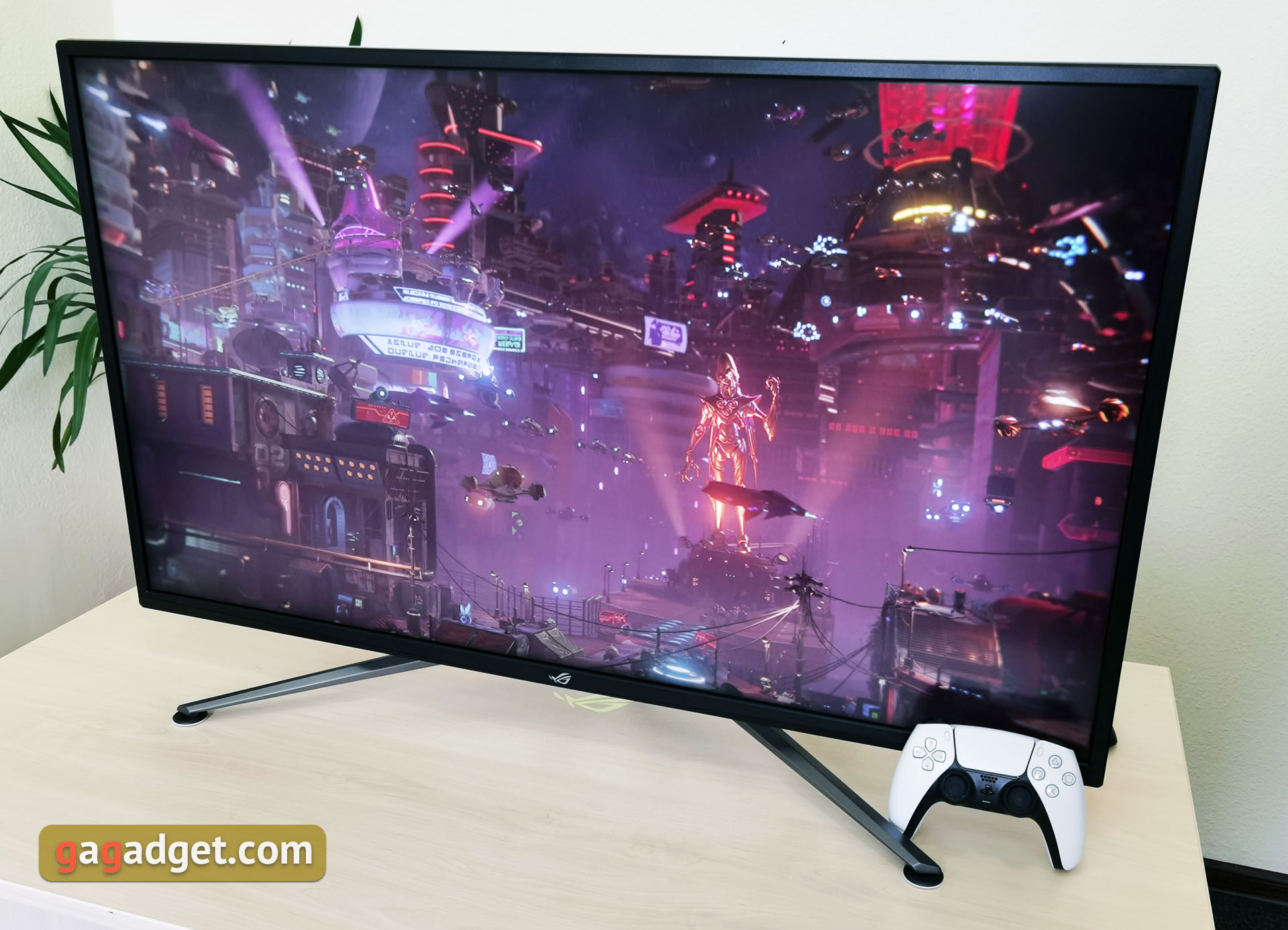
The ASUS ROG Strix XG43UQ is one of the best gaming monitors for those primarily looking for a next-generation console gaming option. It supports 4K@120Hz when connected via HDMI 2.1, and is therefore ideal for PlayStation 5 and Xbox Series X. But the company has not forgotten about PC gamers: using DisplayPort 1.4 you can get 4K picture with a frequency of up to 144 Hz, support for AMD FreeSync Premium Pro and signal compression without loss of quality DSC. The monitor is equipped with an excellent quality VA-matrix with high quality color reproduction, very high maximum brightness, support for Display HDR1000 standard and the pixel response time of 1 ms. A nice bonus is a very good quality and power of the built-in audio system, which is not inferior to the TVs of the corresponding diagonal. The main argument against the ASUS ROG Strix XG43UQ is its price. At the moment it is not on sale, but you should expect about 55 000 UAH. Another thing to consider is the diagonal size of 43 inches may be a bit small if you plan to use the monitor in the living room instead of the TV.
5 reasons to buy ASUS ROG Strix XG43UQ:
- gorgeous 43" VA matrix with very high brightness and Display HDR1000 support;
- refresh rate up to 144Hz, AMD FreeSync Premium Pro, ELMB and technology Display Stream Compression;
- abundant set of ports, including a couple HDMI 2.1 and DisplayPort 1.4;
- loads of operation modes, extra gaming features and bonus remote control;
- impressive power and sound quality.
2 reasons not to buy ASUS ROG Strix XG43UQ:
- very high cost;
- you have a large living room and need a bigger diagonal.
Quick link:
- What's in the box?
- What does the ASUS ROG Strix XG43UQ look like?
- What about usability, adjustability, and connectors?
- How is ASUS ROG Strix XG43UQ doing with picture quality?
- How did it perform and what about sound quality?
What's in the box?

The huge box of the ASUS ROG Strix XG43UQ itself is packed with a considerable amount of accessories. DisplayPort, HDMI, USB 3.0 hub cables, remote control, removable projector backlight, power cable, power supply, ROG sticker set, documentation (including factory calibration report), and even a hexagon.
What does the ASUS ROG Strix XG43UQ look like?
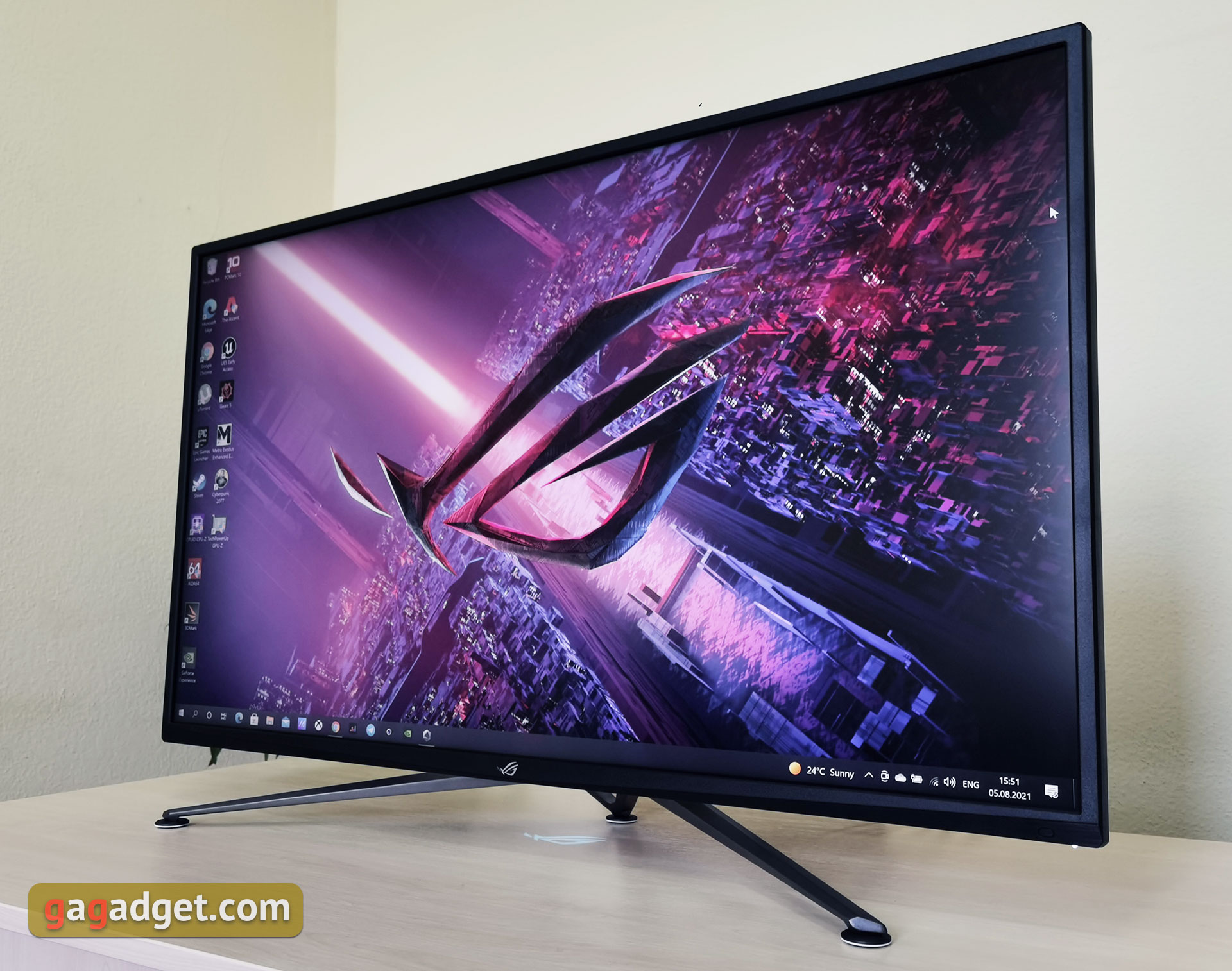
The ASUS ROG Strix XG43UQ looks more like a TV than a monitor. Although by today's standards, 43 inches is a bit small for a TV. At the same time, the front of the monitor does not look flashy: not too wide black plastic frame around the perimeter with ROG logo on the bottom. Giving off the gamer positioning is the backlighting that projects the ROG logo onto the table below the monitor. But it's switchable. What's more, it can be removed altogether.
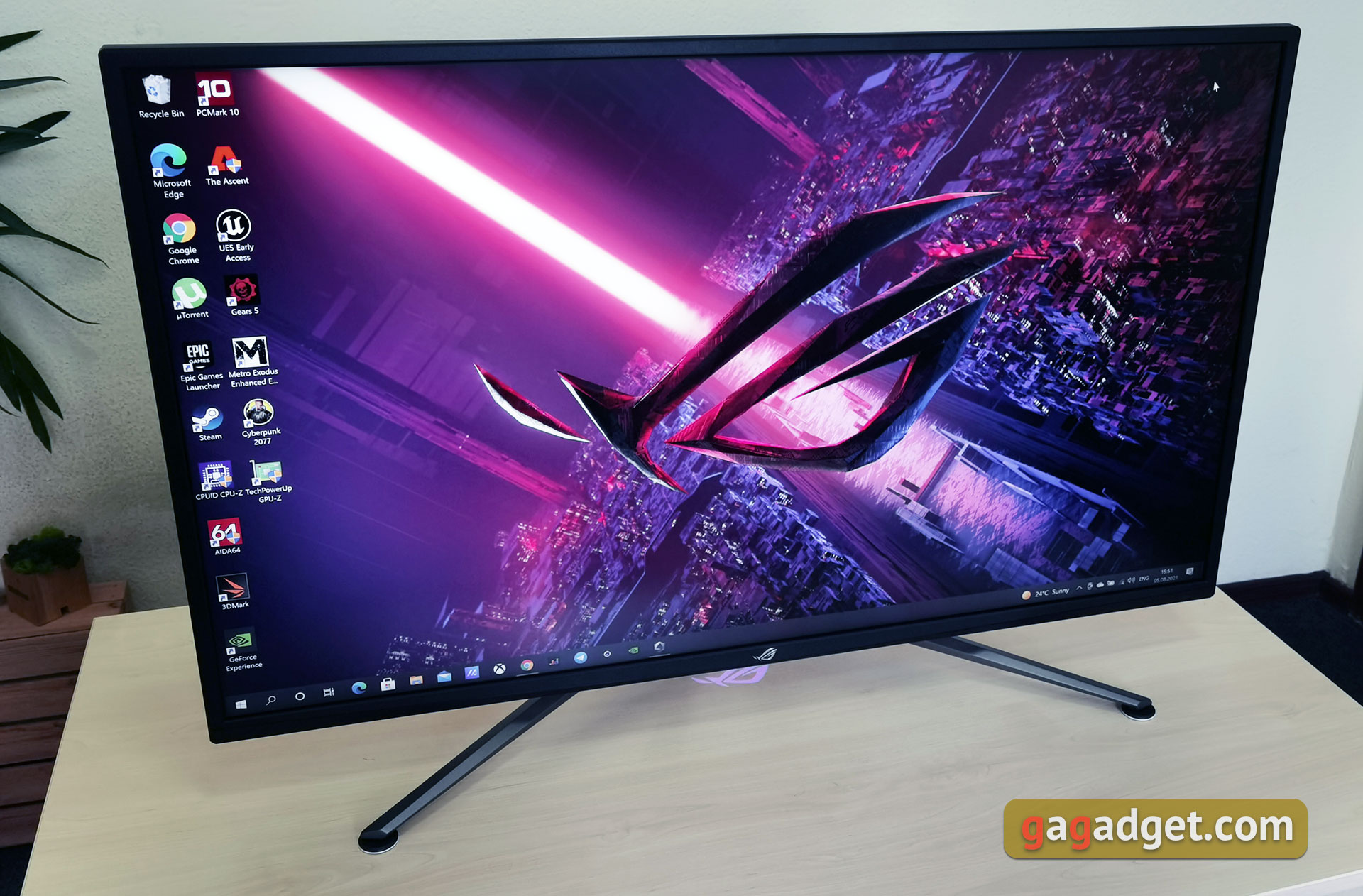
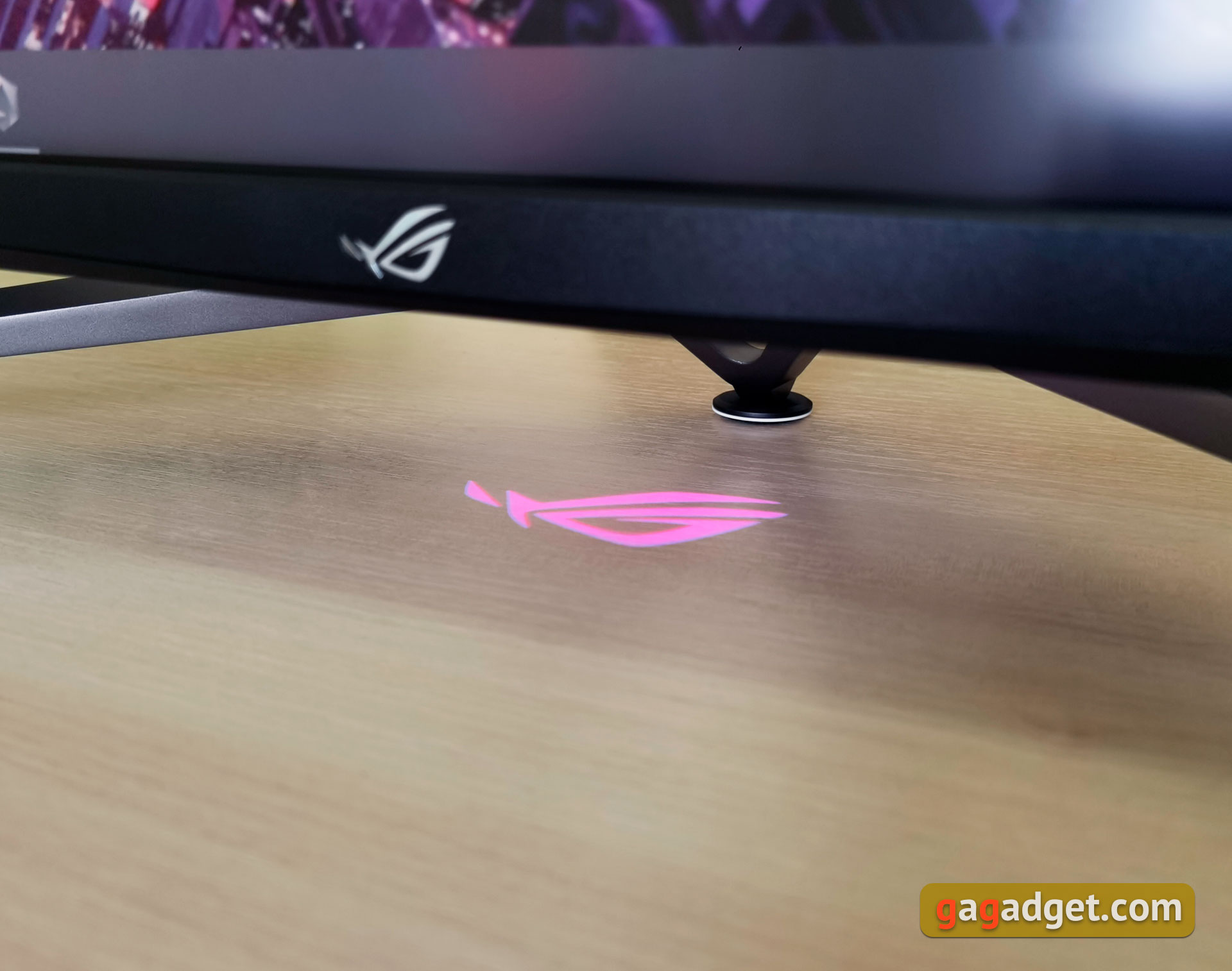


It is attached with a screw to the back side of the monitor, next to the stand mount and connected to the corresponding AURA port. The stand itself is metal and massive. It has a wedge shape and very impressive size which is not surprising considering its diagonal size. For extra stability and (probably) to avoid damaging the table there are three additional round rubber pads at the bottom of the stand.
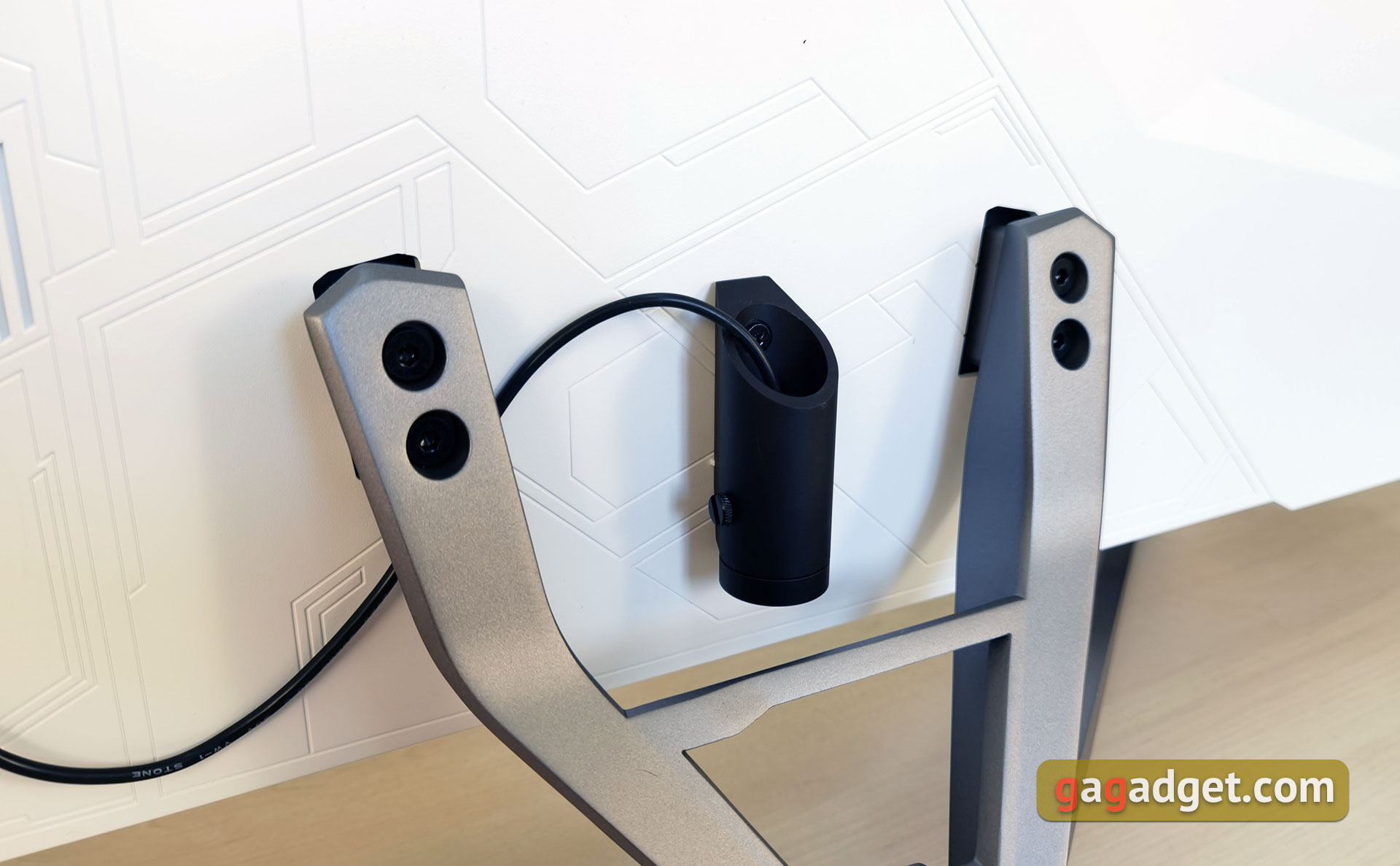
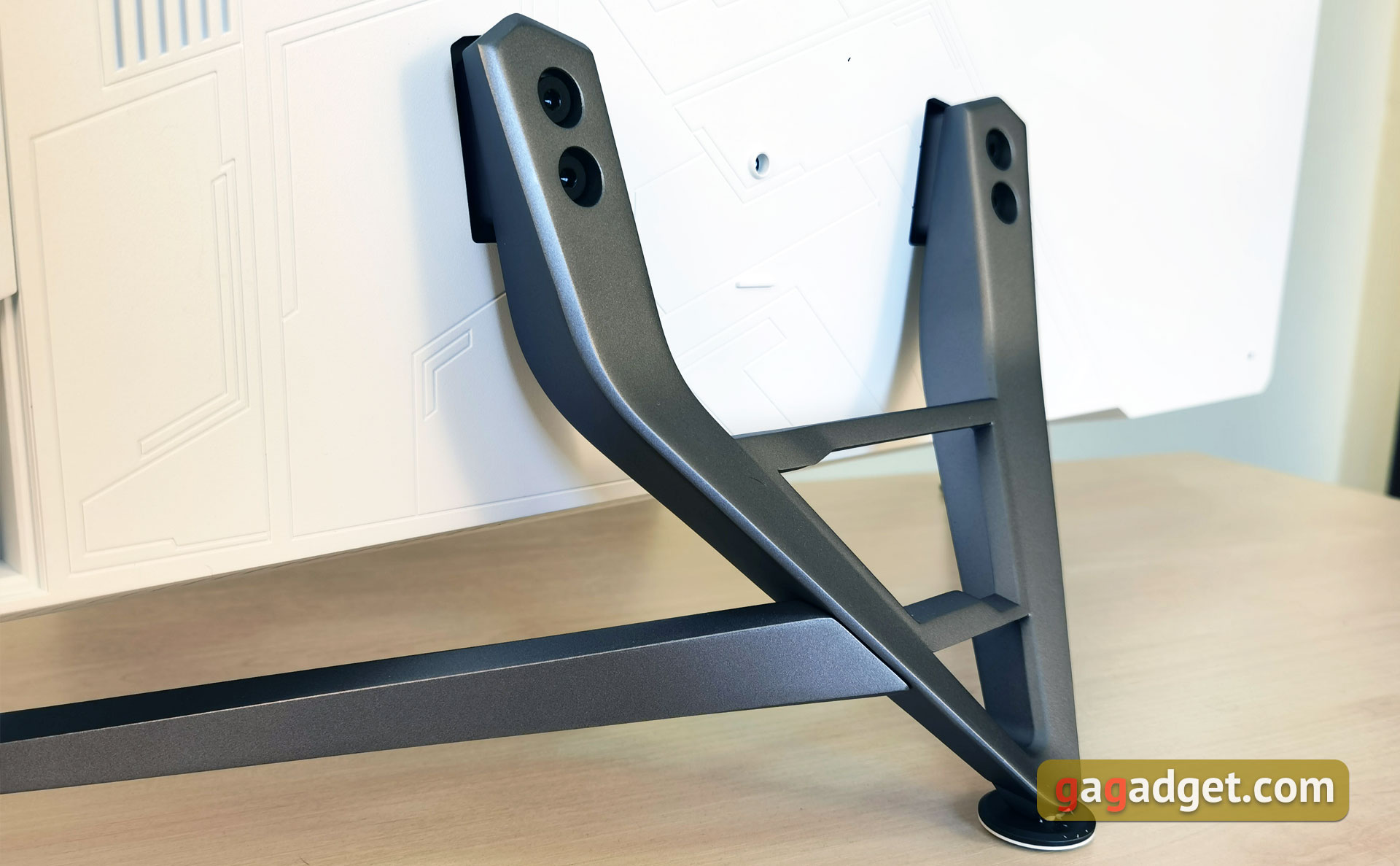






The entire back panel is made of matte white plastic. Just the way a PlayStation 5 or Xbox Series S would look organically. The surface is dotted with lots of vents and covered in geometric patterns already familiar from other ROG models. On the right side is a large lineup logo. In the middle are four holes under white plugs. They are for wall mounting the monitor, VESA standard 100x100. The stand can be unscrewed with the hexagon socket provided. In the lower right corner there is a socket for Kensington Lock.

The monitor doesn't take up too much space in the back. However, keep in mind the diagonal size: it is not very comfortable to sit in front of a 43" monitor from the same distance as you would sit in front of a more conventional smaller model.
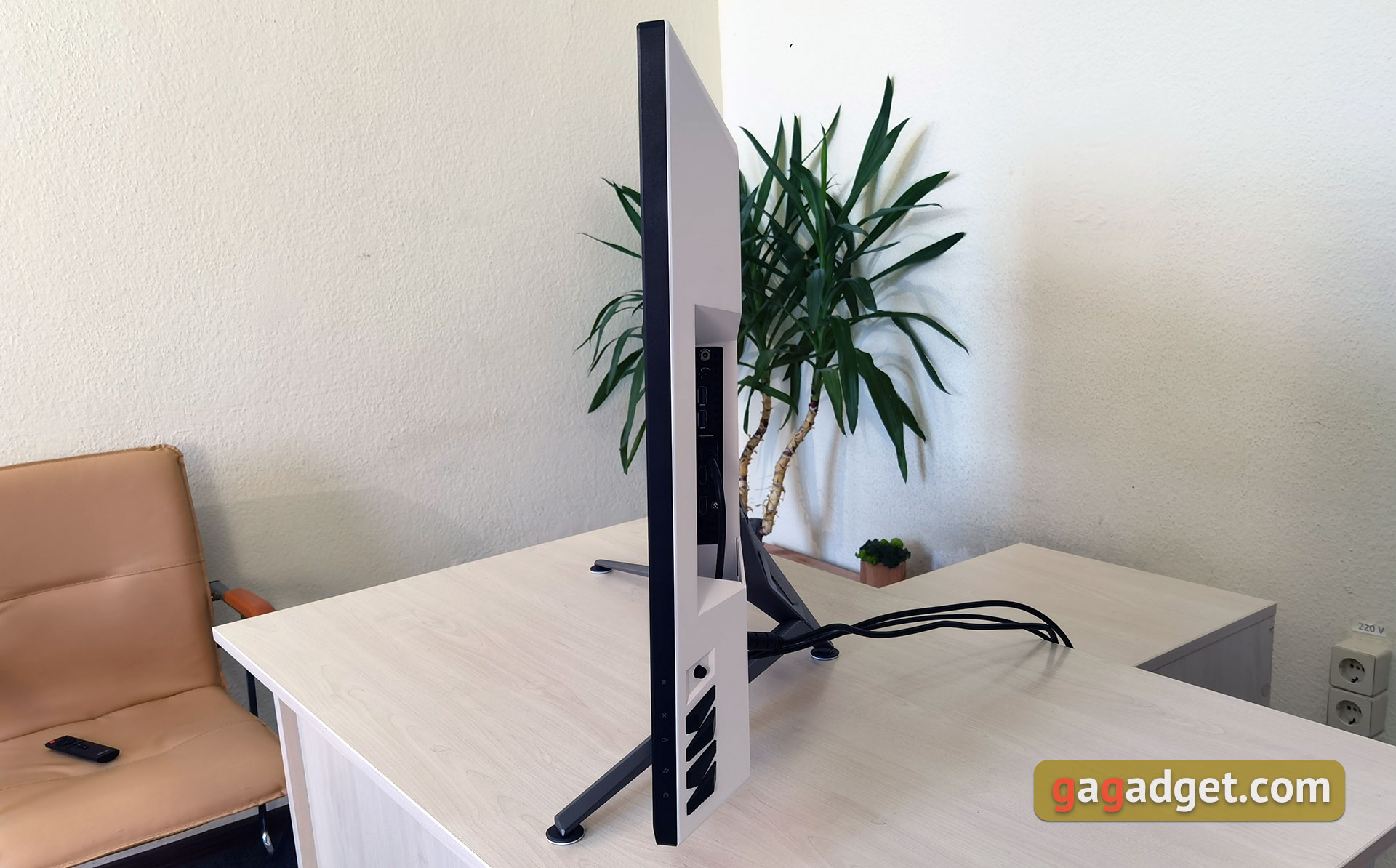
The monitor control panel is comprised of four buttons and a five-position joystick, like in all ASUS gaming models. It's located in the left bottom corner of the monitor's rear panel. On the side there are stickers to make it easier to find your way around.
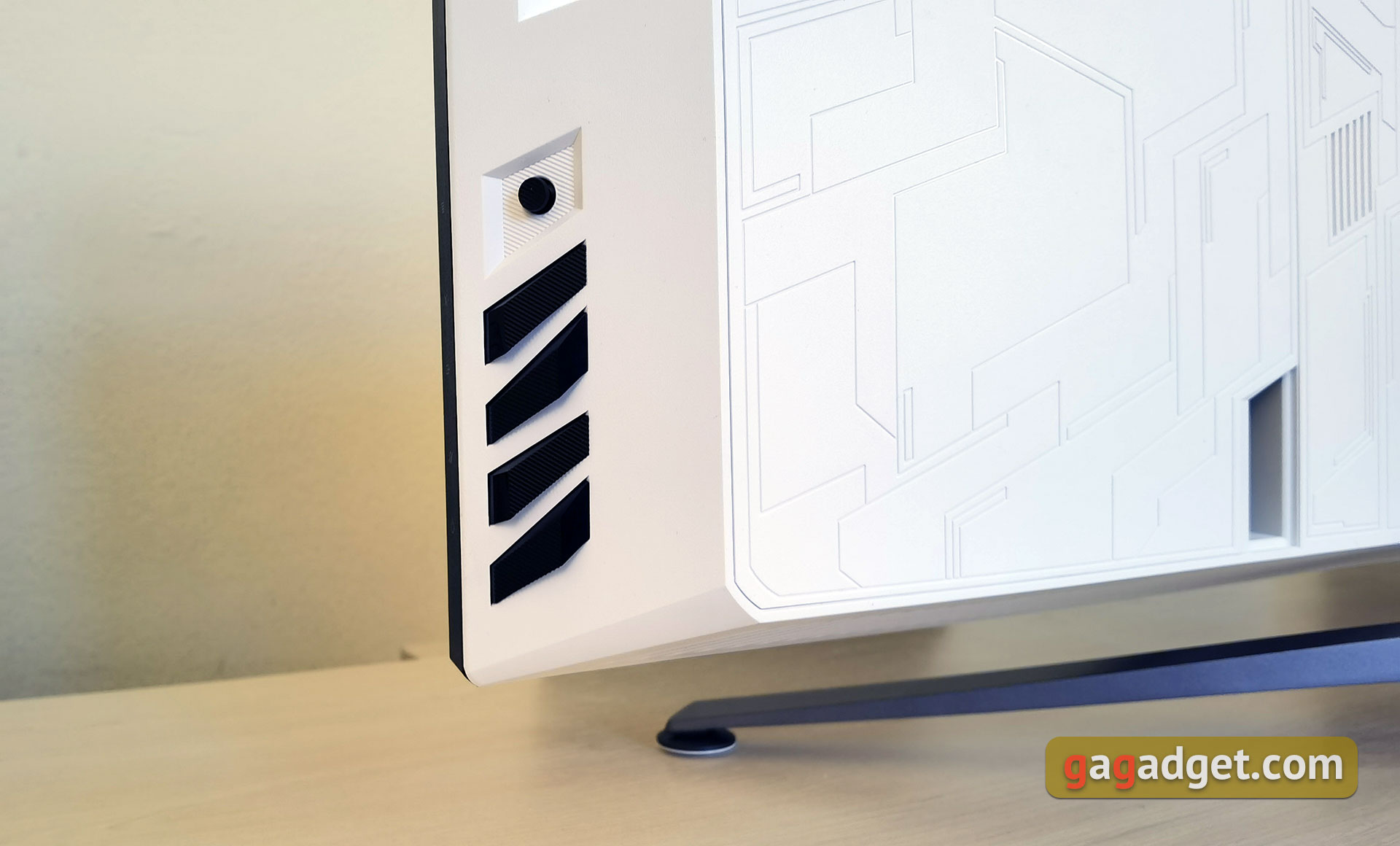
All connectors are located on two areas, one facing down and the other to the side. Similar solutions are used in TV sets. For a more aesthetic appearance there is a removable cover which covers the cables and the lower plate with connectors.






On the bottom right there is a small white LED indicating the monitor operation. Next to it on the front panel is a small window for receiving IR signal from the remote control.

ASUS ROG Strix XG43UQ has a solid construction that won't shake, rattle or crack. As for the appearance, it turned out to be quite versatile. Although, subjectively, the front panel would look more interesting the same white as the rear.
What about usability, adjustments and connectors?
On the side panel with connectors there are two HDMI 2.0 ports, a USB hub with two USB 3.0 ports (and a port for connecting them nearby) as well as two 3.5 mm jacks for connecting a headset. The second panel is facing downwards and is located under the decorative cover. This means that these connectors are not often accessible. On this panel there are two HDMI 2.1, one DisplayPort 1.4, a power connector and an AURA port (which is actually an ancient MiniUSB) for backlight connection.

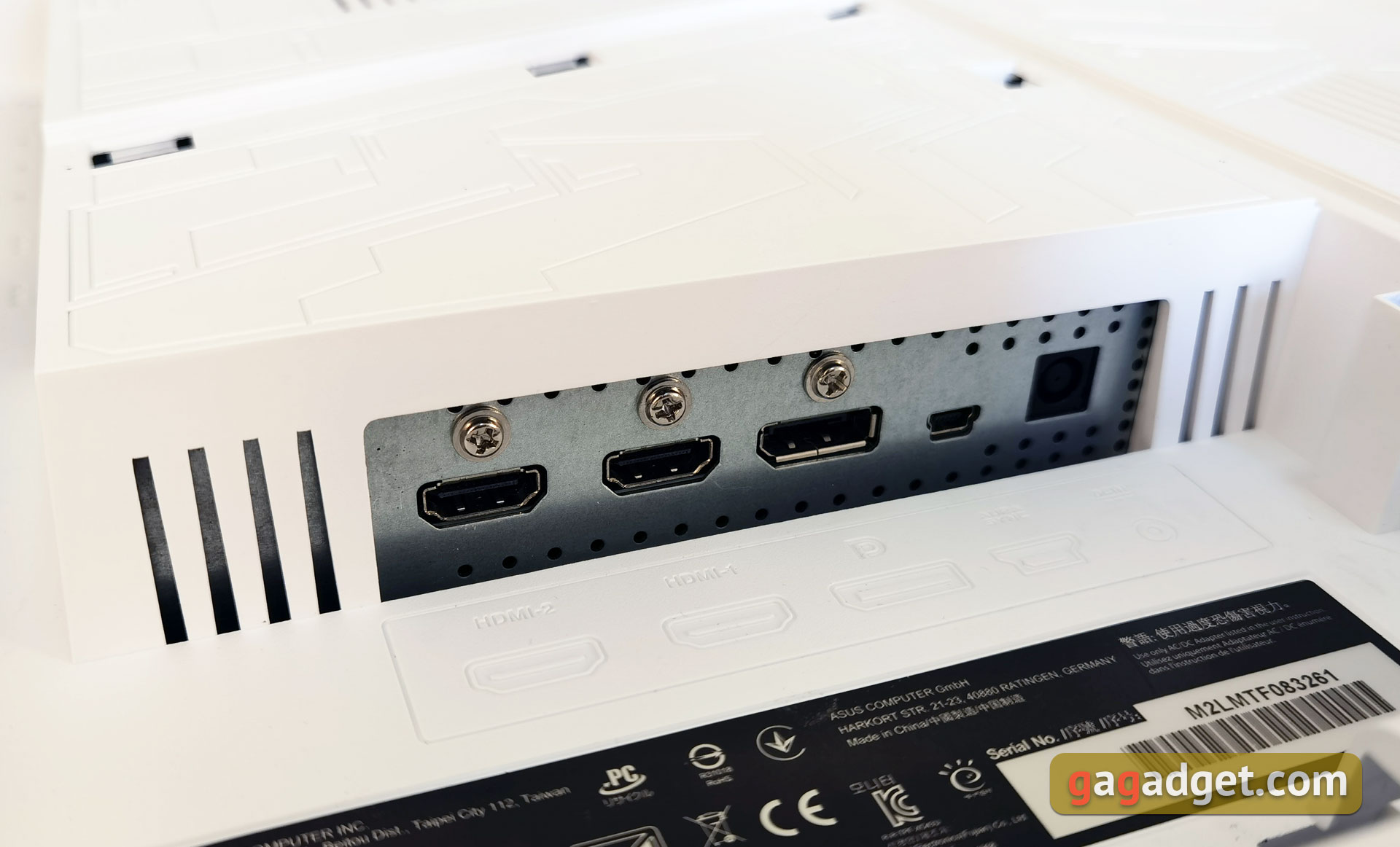


The stand is not very functional. In fact, it only allows you to adjust the monitor's angle in the range of +10° to -5°.
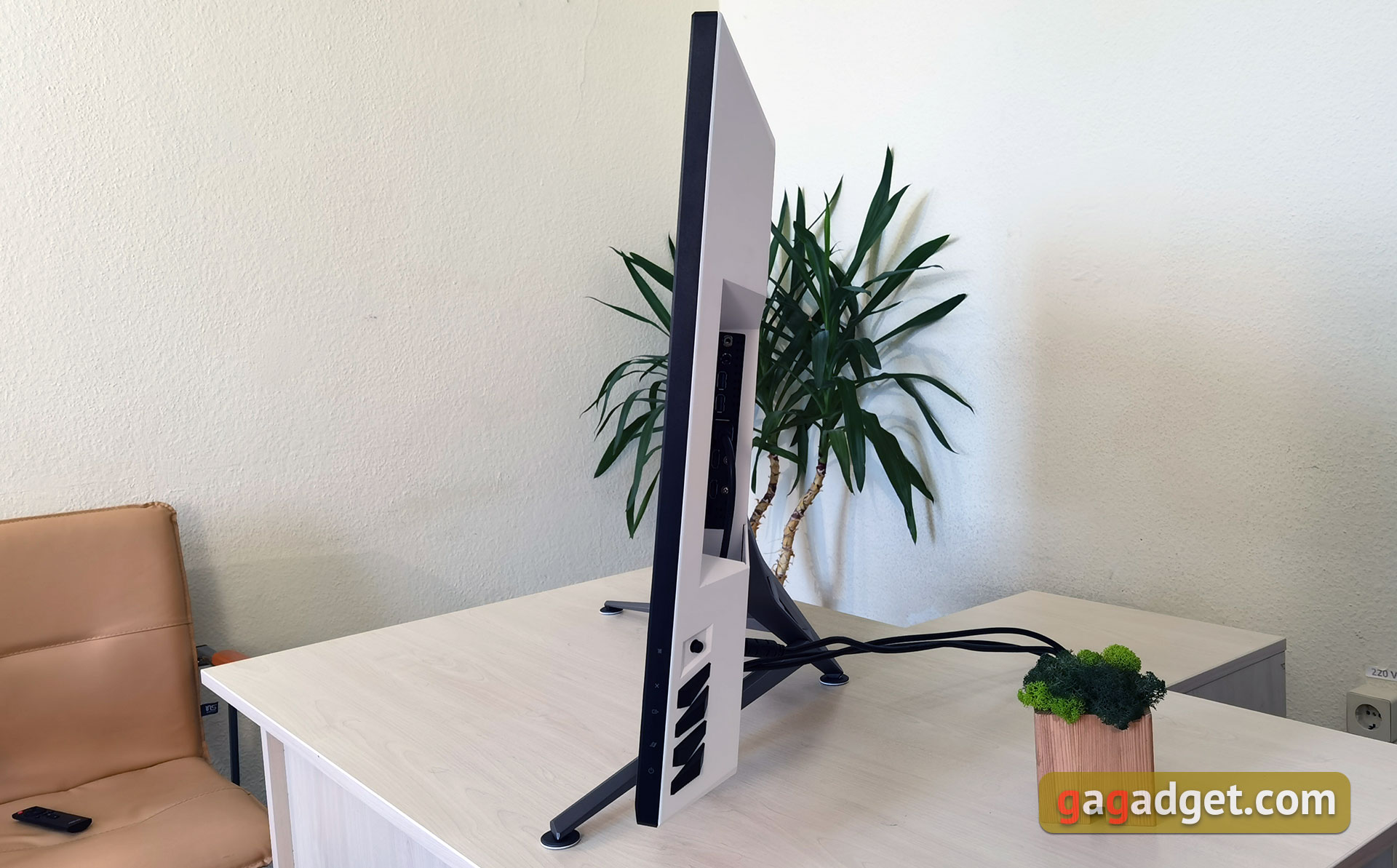
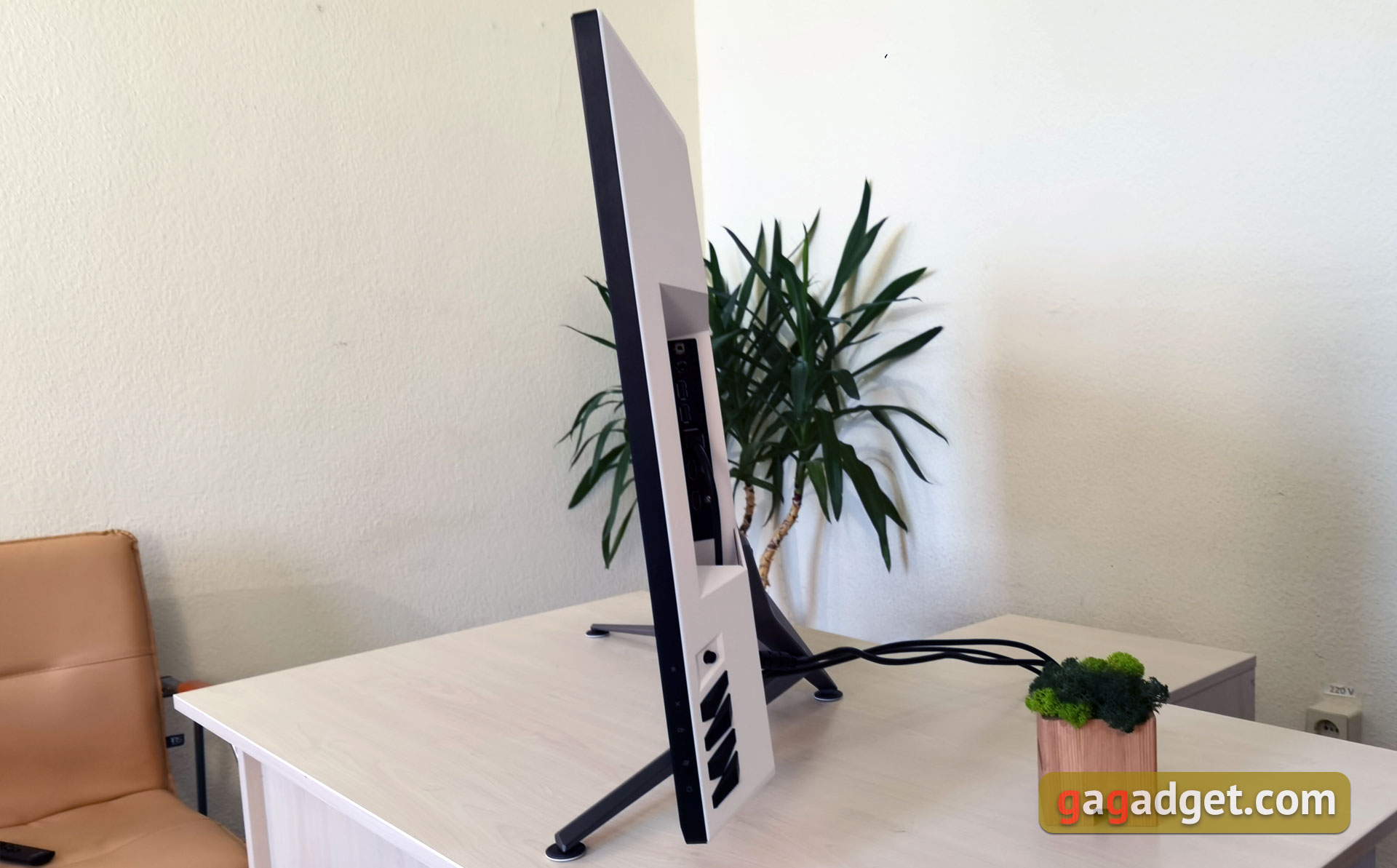

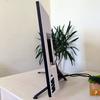
Button control is implemented in the usual way for ASUS monitors. The joystick is responsible for menu navigation and confirmation. The buttons below are the undo button (also bringing up the button function names), source selection, GameVisual image mode switching and the power button.
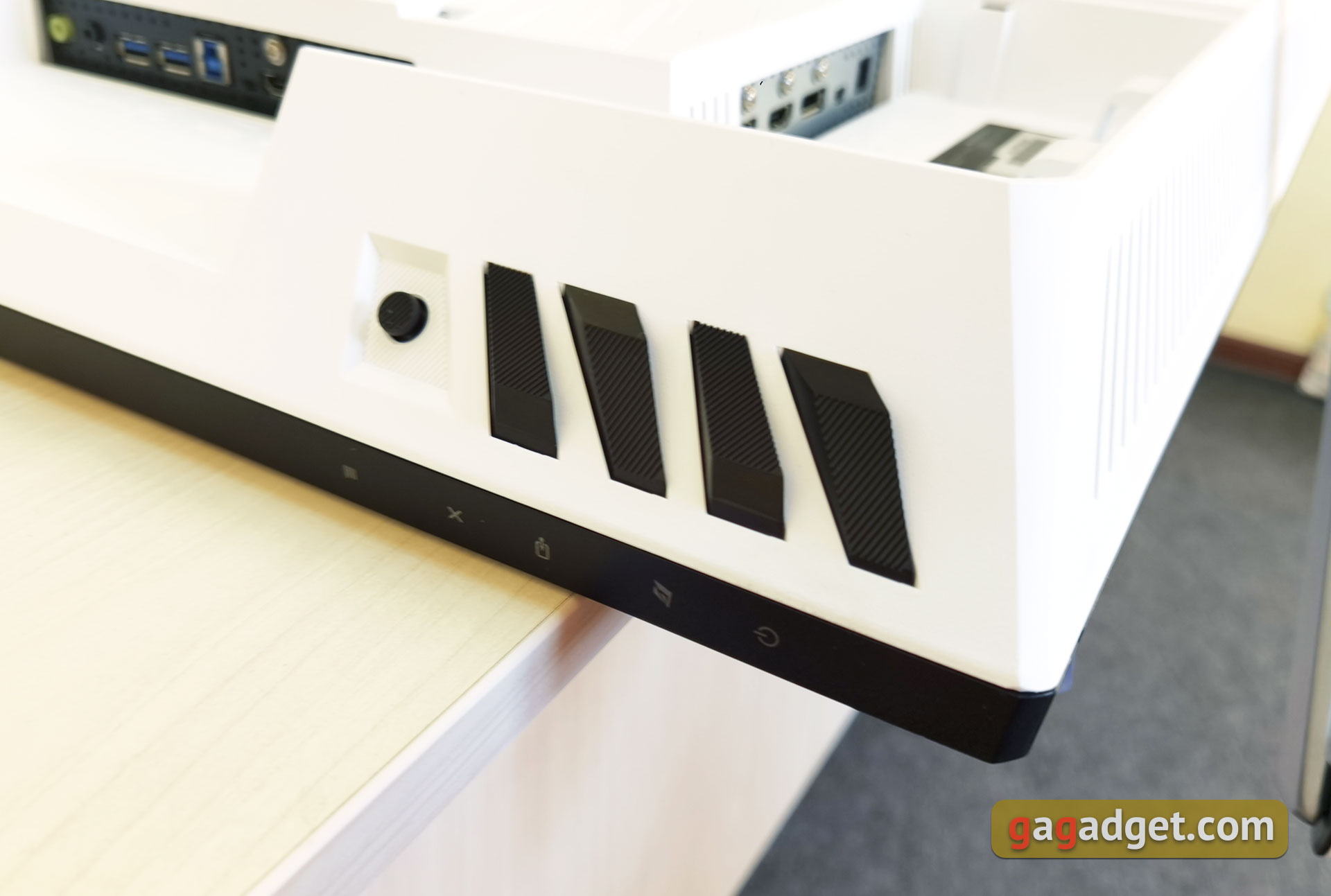
The OSD menu is divided into sections, with the current resolution, refresh rate, color mode, AURA and HDR backlight activity displayed at the top right. The first item of the Gaming menu adjusts matrix overclocking, AMD FreeSync Premium Pro frame rate sync, ELMB - Extreme Low Motion Blur to reduce motion blur by inserting a black frame (and ELBM Sync). It can't work at the same time as FreeSync Premium and when activated it blocks brightness. Then there's the GamePlus and GameVisual section with a bunch of presets including sRGB, FPS, Racing, MOBA, Cinema and so on. The last item is ShadowBoost shadow highlighting. The next sections of the menu are Image and Color, where you adjust the brightness, contrast, HDR, gamma, saturation and color temperature of the picture. The next sections are signal input selection, Picture-in-Picture settings if multiple sources are connected and backlight adjustment, where you can select color and effect locally on the monitor or enable AURA Sync to synchronize backlight with other ASUS ROG devices. The MyFavorite section allows you to reassign actions to physical buttons, which by default are responsible for source selection and GameVisual mode switching. The last section of the OSD is responsible for general settings, including menu language, reset, sound setting, power saving mode, operation indicator, and so on.

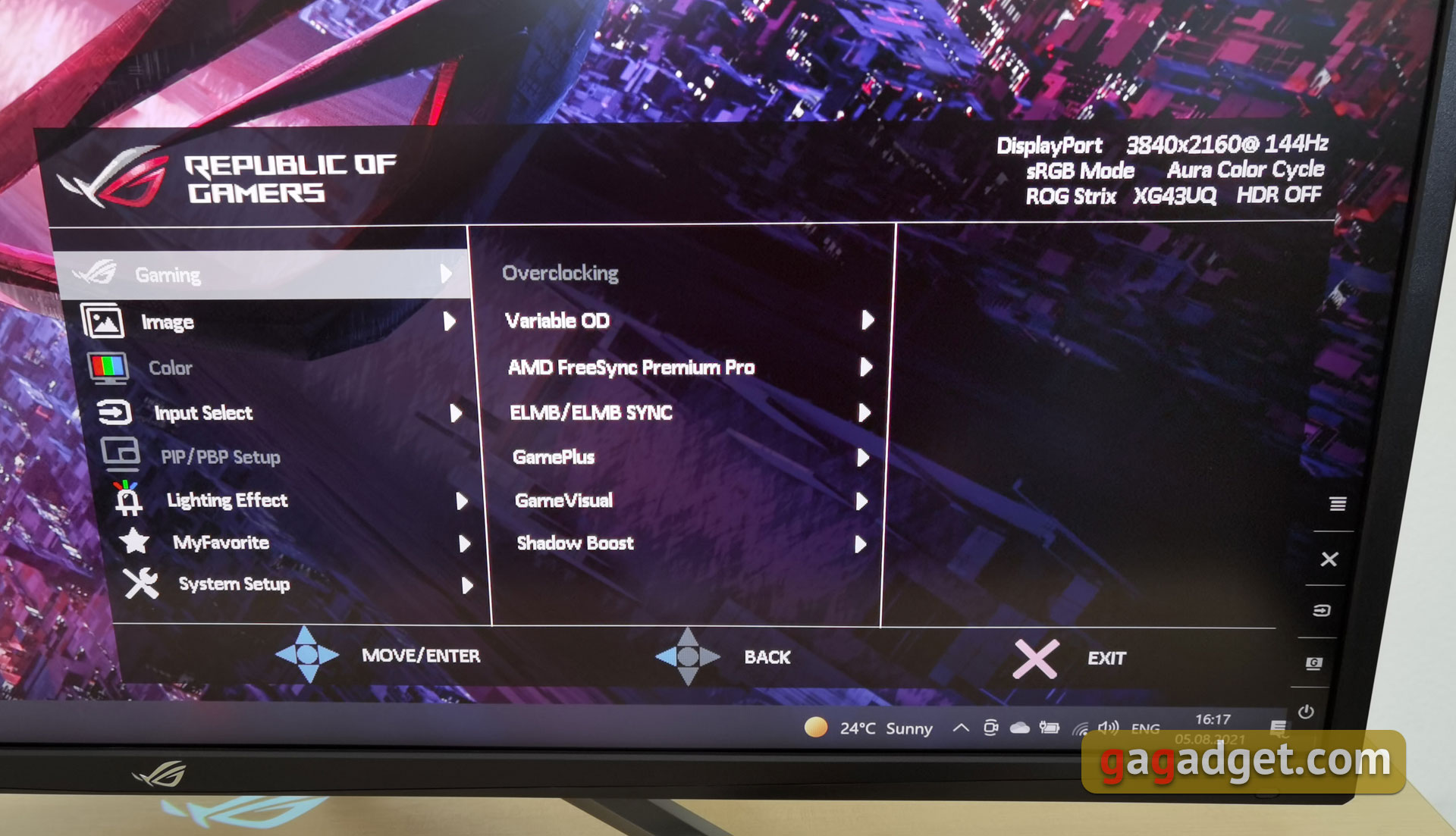
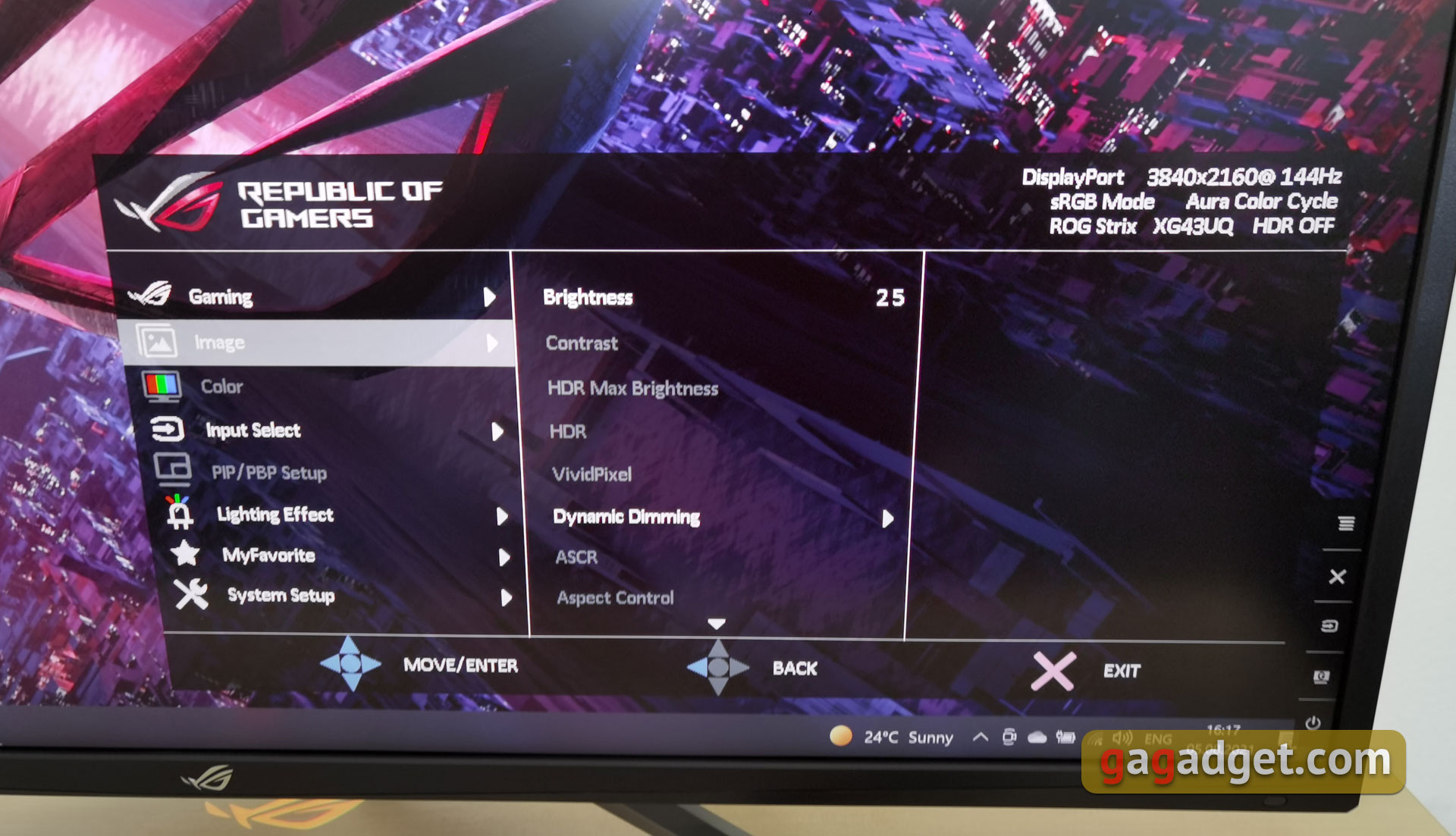
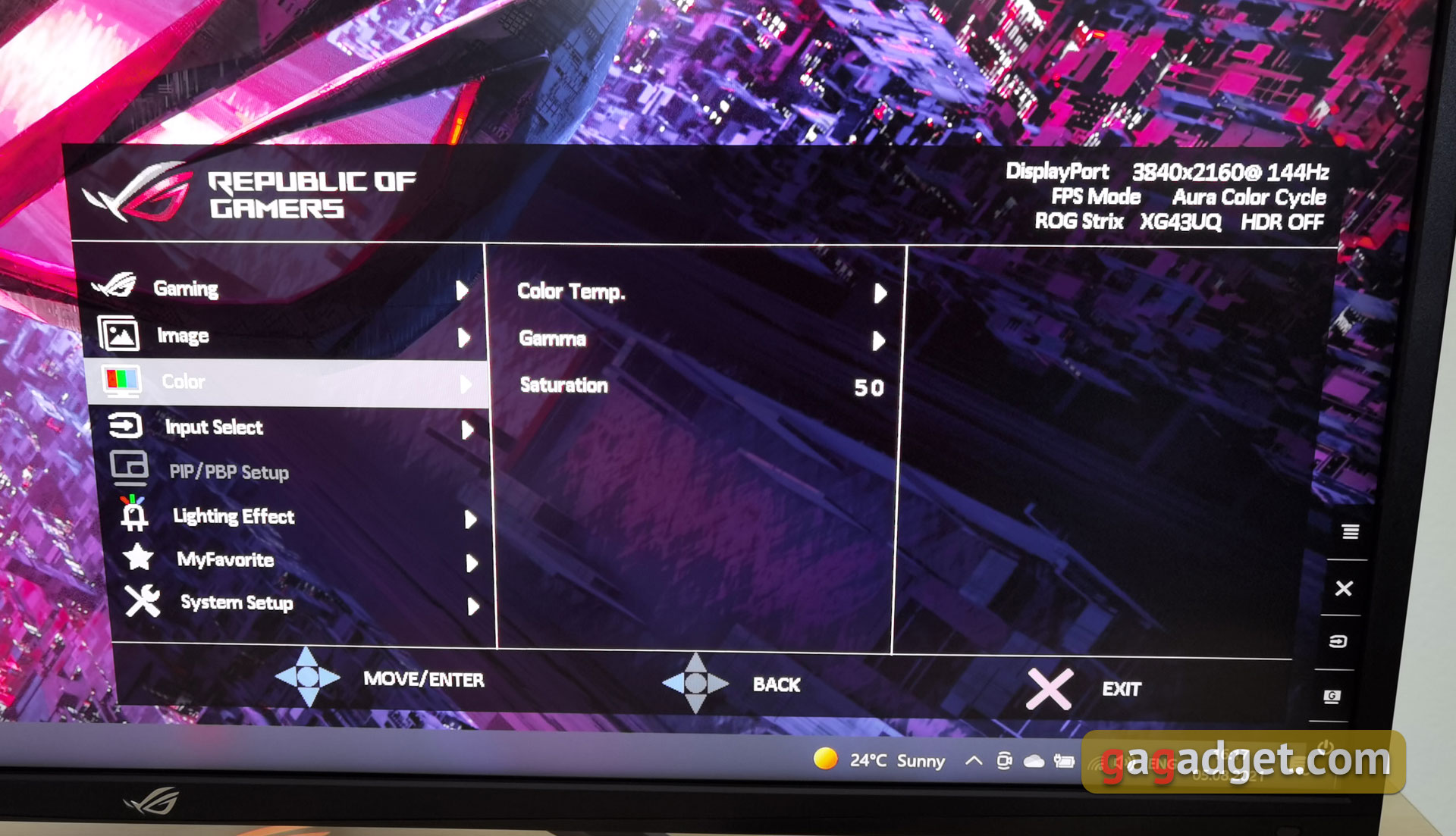
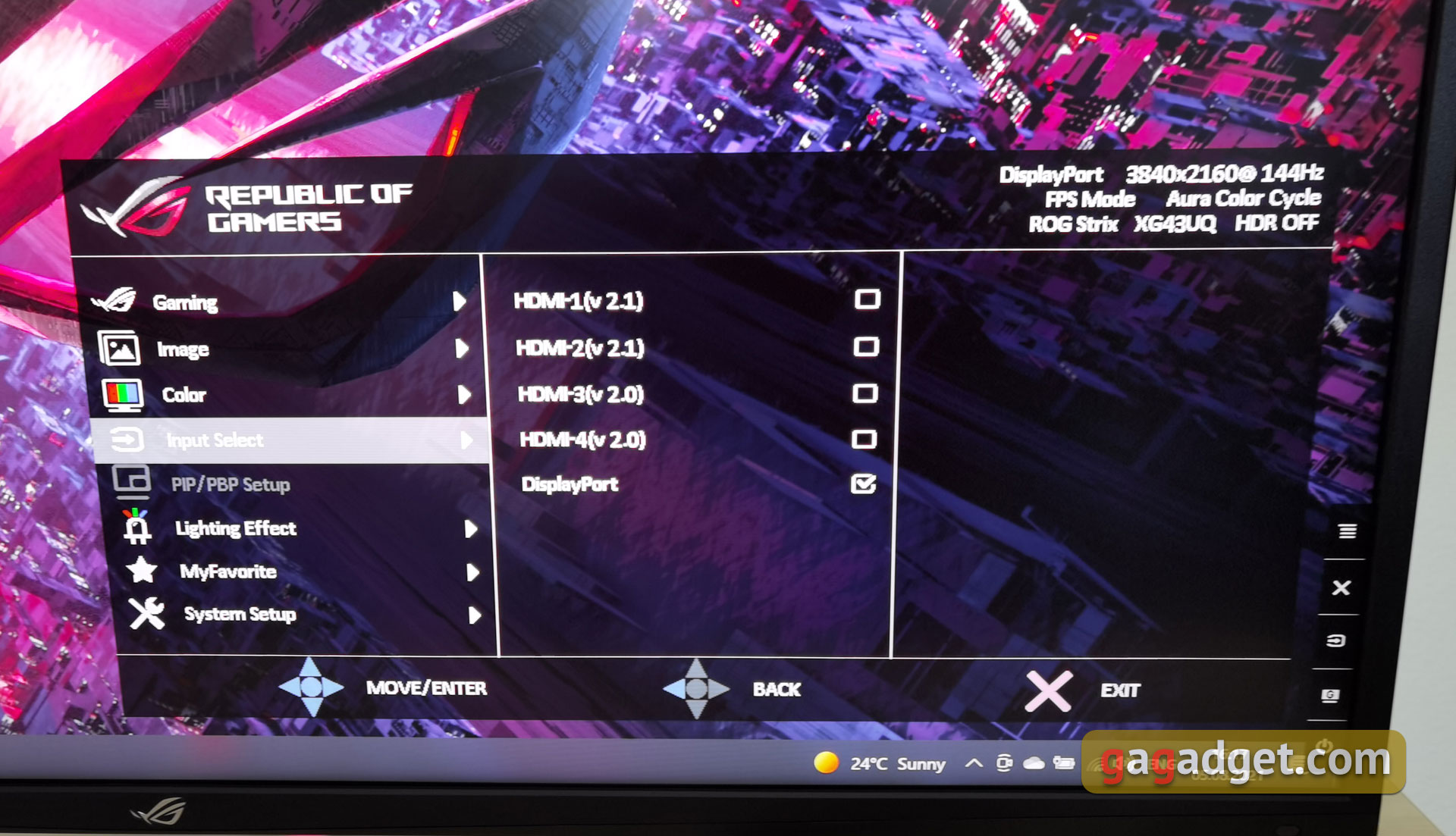
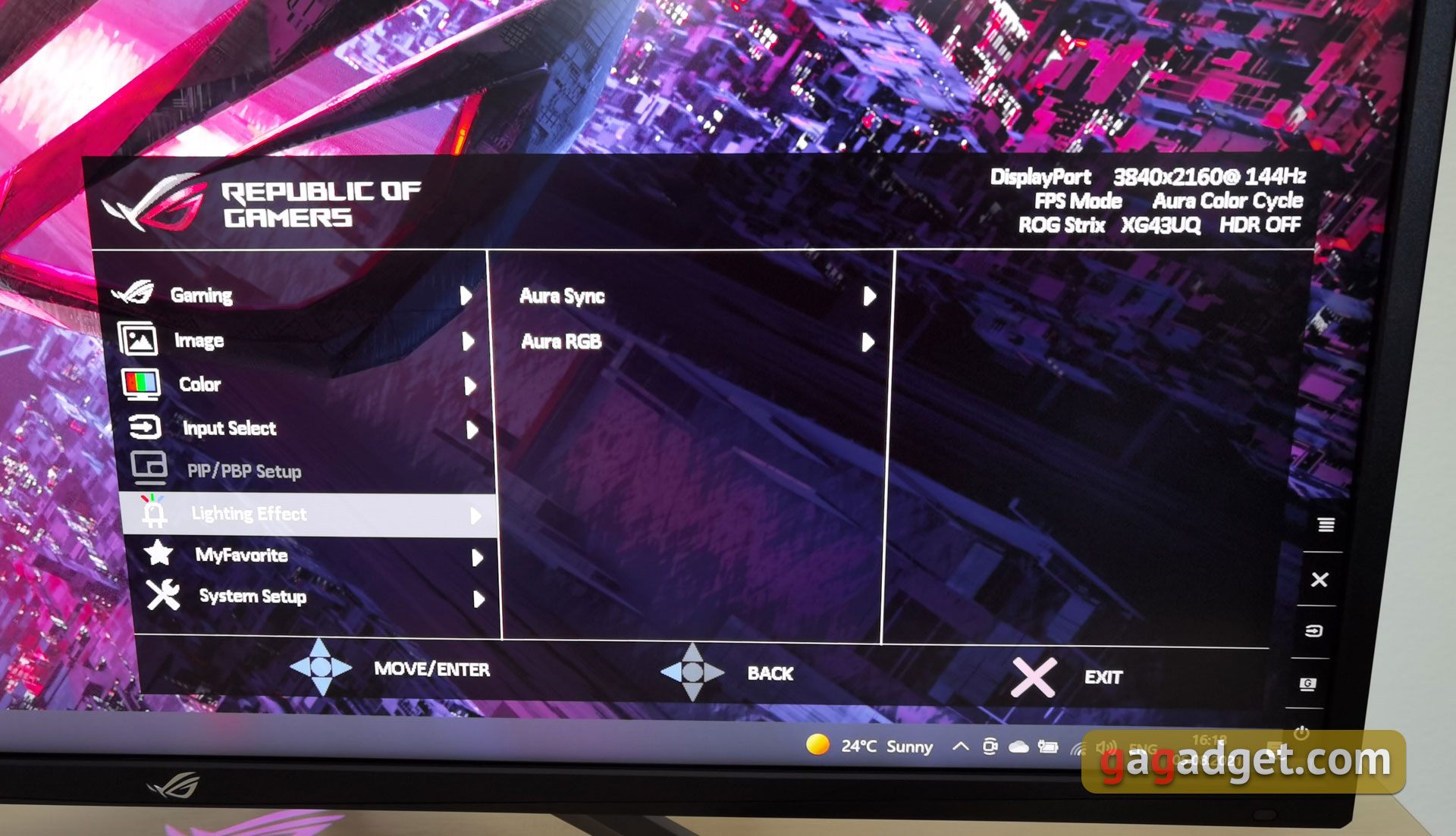
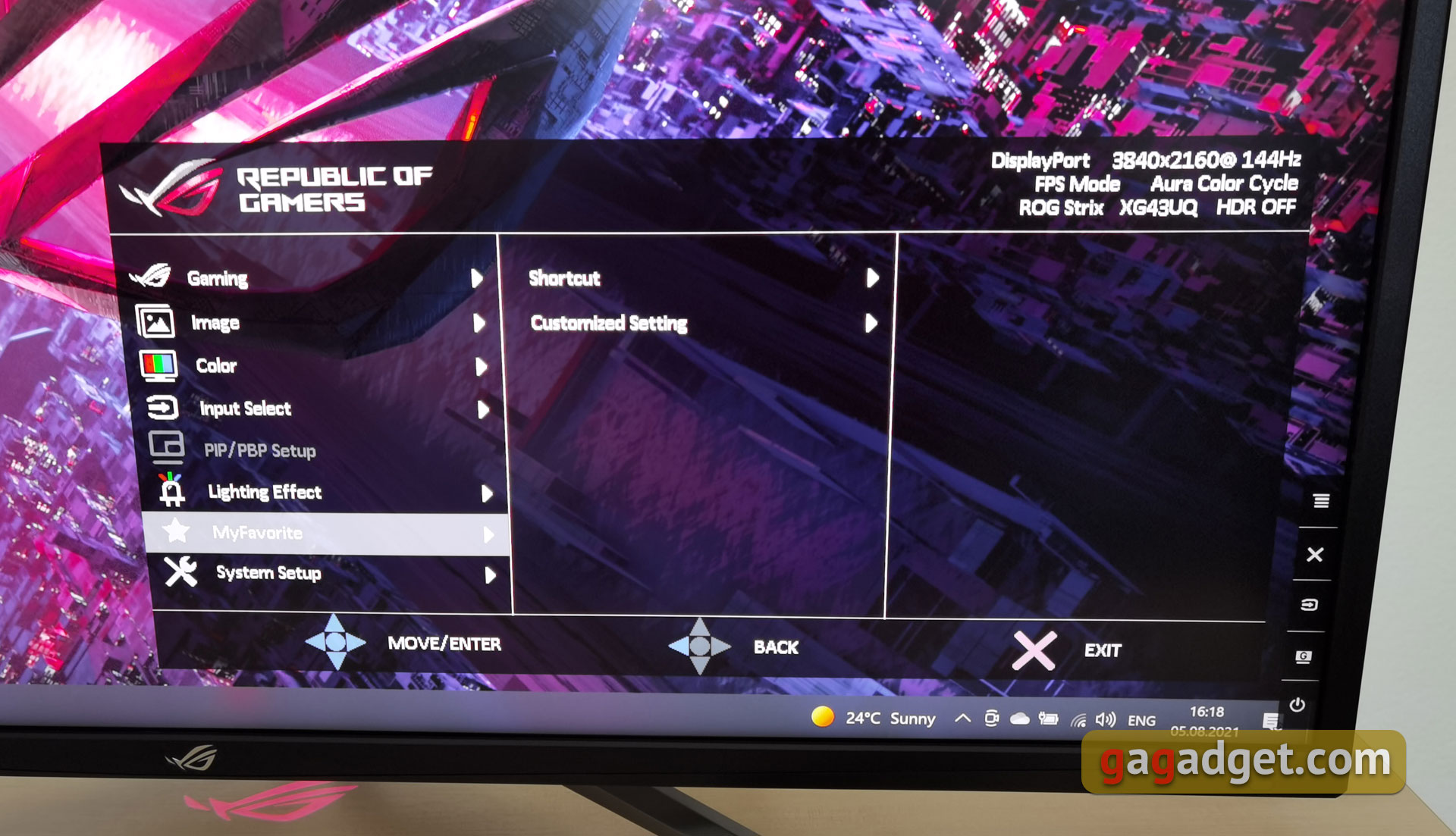
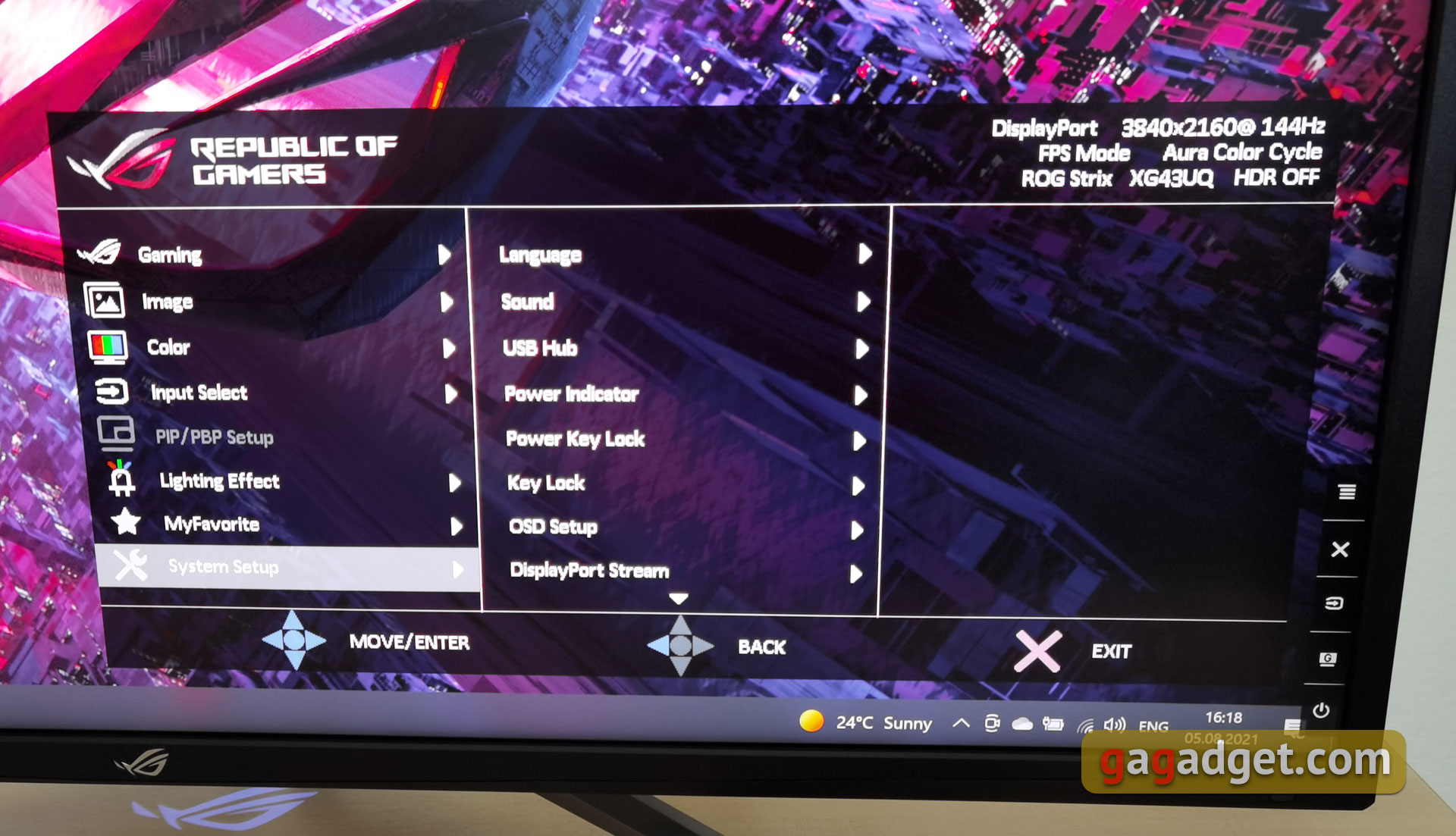
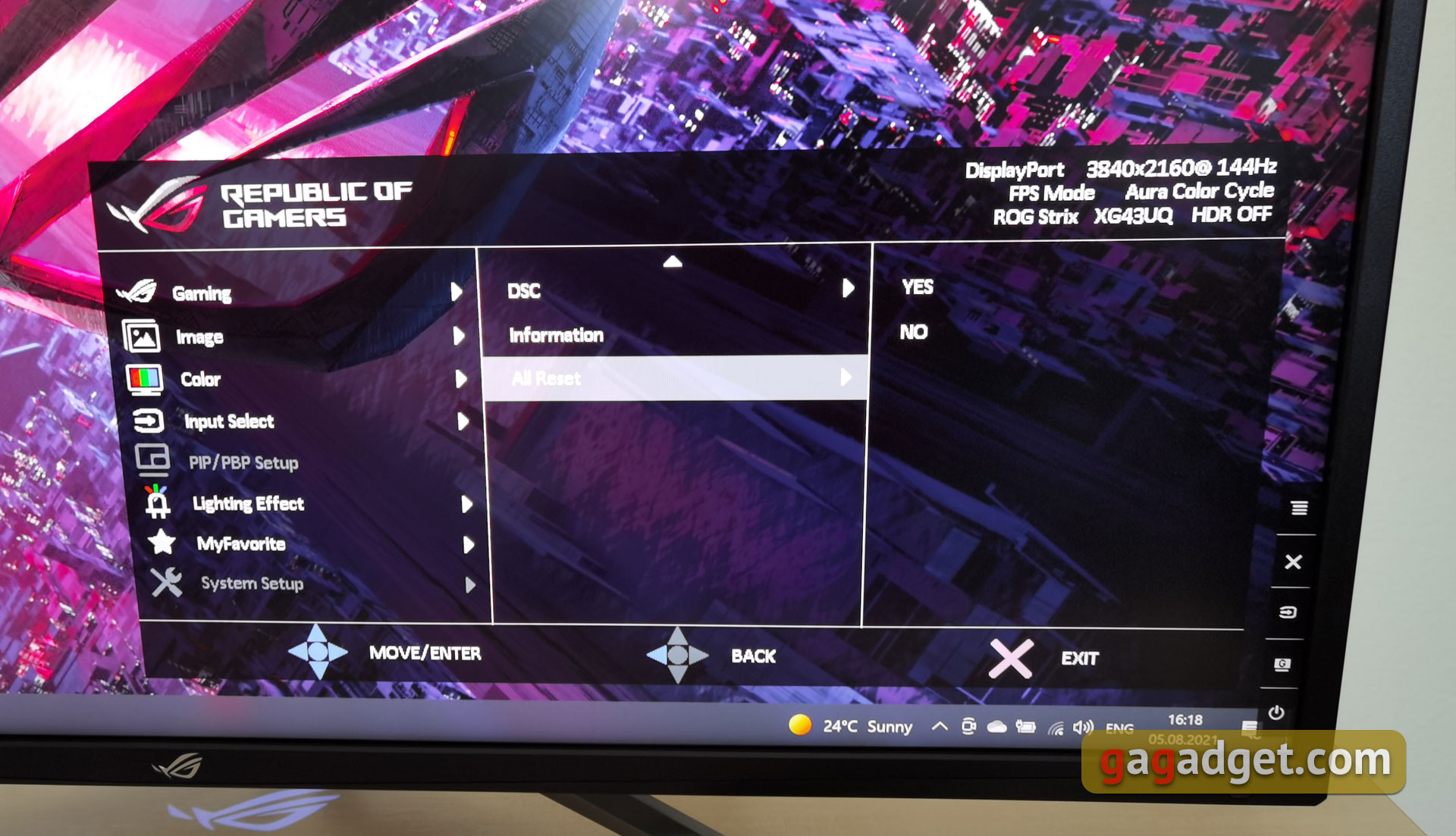









All this can be done by means of the included remote control that seems to hint us that this is no ordinary monitor in front of us. And it is quite possible to install it in your living room in the TV's place. At that the OSD launched from the remote control is displayed in enlarged view to be seen from a longer distance.
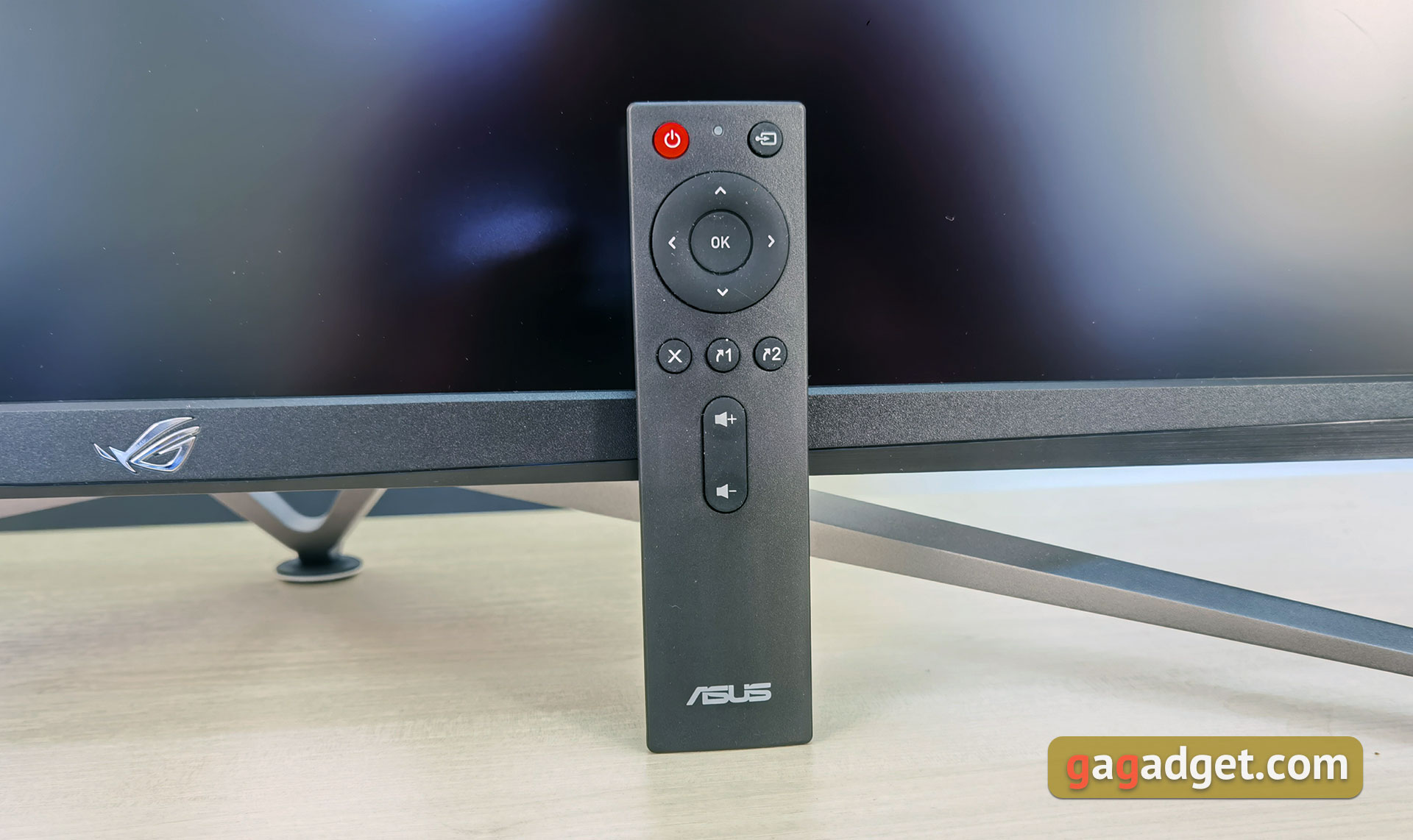
How does the ASUS ROG Strix XG43UQ do with picture quality?
The ASUS ROG Strix XG43UQ features a 43.4-inch VA panel with a matte finish, 4K resolution (3840x2160) and W-LED backlighting. The website states that it is a 10-bit matrix. In fact, this is only partially true: 8-bit + FRC. Although, getting ahead of ourselves, it's worth saying that this isn't a problem at all. The color gamut is 90% of the DCI-P3 color space. The maximum refresh rate is 144 Hz and the minimum pixel response time is 1 ms MPRT (Motion Picture Response Time). Maximum claimed brightness is 750 cd/m² and the peak value is 1000 cd/m². The monitor complies with DisplayHDR 1000 standard. Also it's worth mentioning that the monitor supports DSC (Display Stream Compression) standard that allows DisplayPort to transmit the picture without loss of quality with minimal delay.

The picture on the ASUS ROG Strix XG43UQ is impressive. Both in terms of brightness and color saturation. Thanks to the VA matrix, the picture is very contrasty, and blacks are deep. Viewing angles are maximum. Yes, the contrast drops a little and very little yellowish shades appear, which is characteristic of VA. But it is expressed minimally. The glow effect is almost absent, and backlight uniformity is very good. Any flashes can be seen, perhaps, only in a completely dark room at maximum brightness. Thanks to the high maximum brightness, HDR content looks very cool on the monitor, be it games or movies. The only thing that can be confusing is the slightly higher minimum brightness: in total darkness the picture can seem too bright.
The tests were performed in four modes with the monitor completely reset to the factory settings. The colorimeter measurements showed that in FPS mode the brightness was an impressive 727.104 cd/m² (almost the same as the claimed 750), black field brightness was 0.365 cd/m² and the static contrast ratio was 1992:1. Color rendering is also good: color gamut is slightly wider than sRGB, color temperature is between 6500 and 7500K, blue overshoot is minimal.

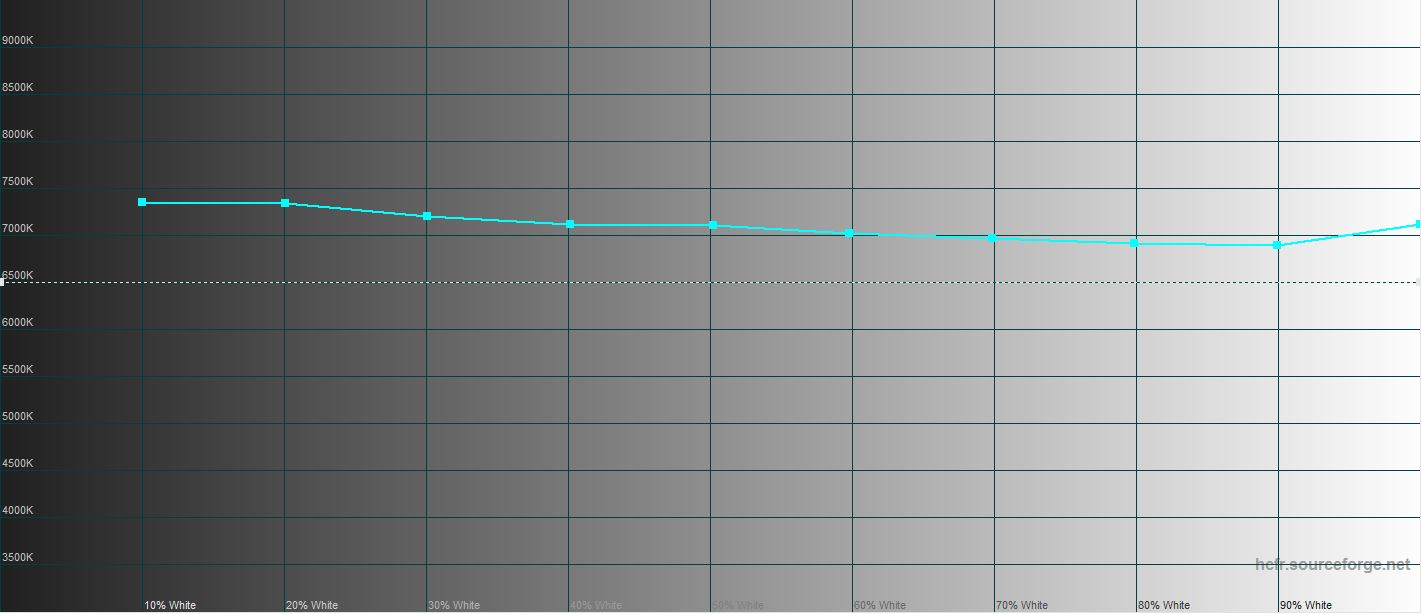
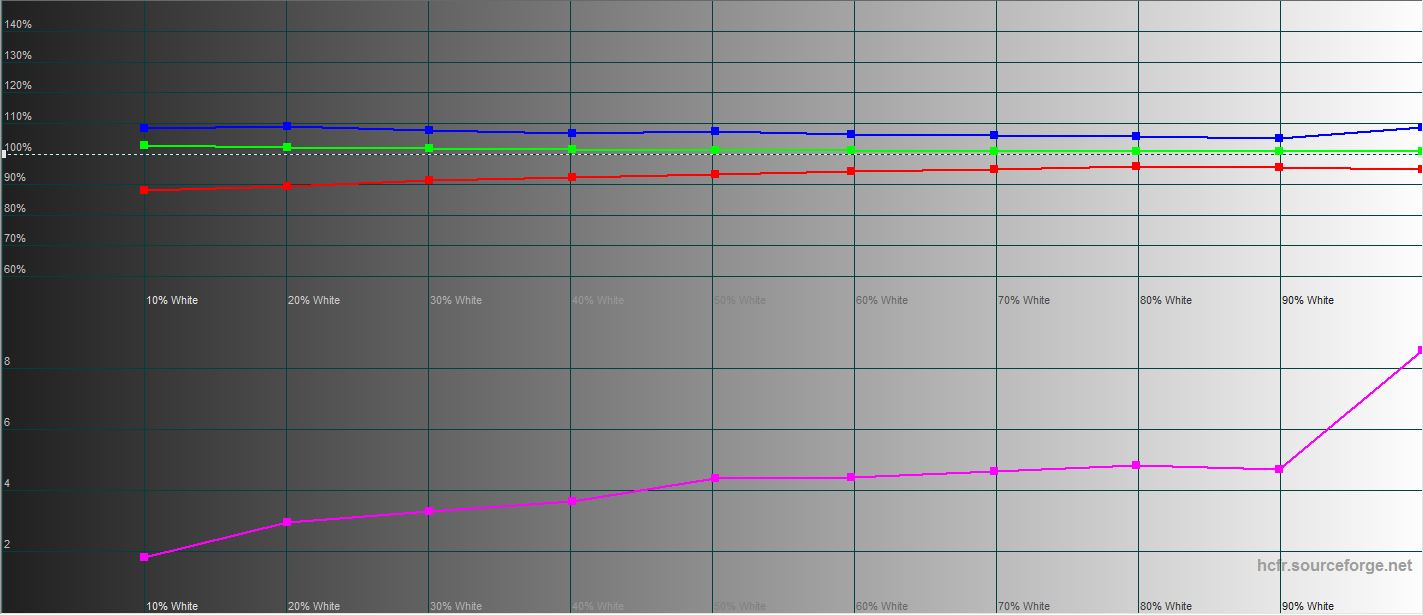







In RPG/RTS mode all indicators are almost the same. Maximum brightness: 727.91 cd/m²:
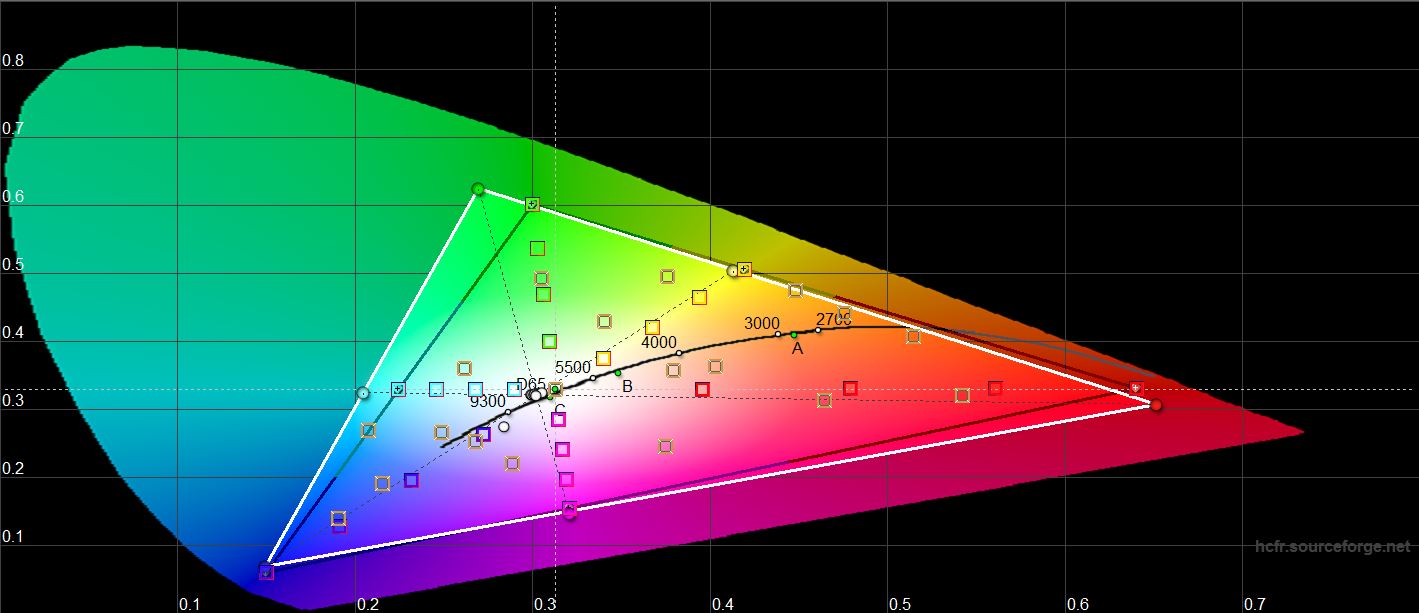
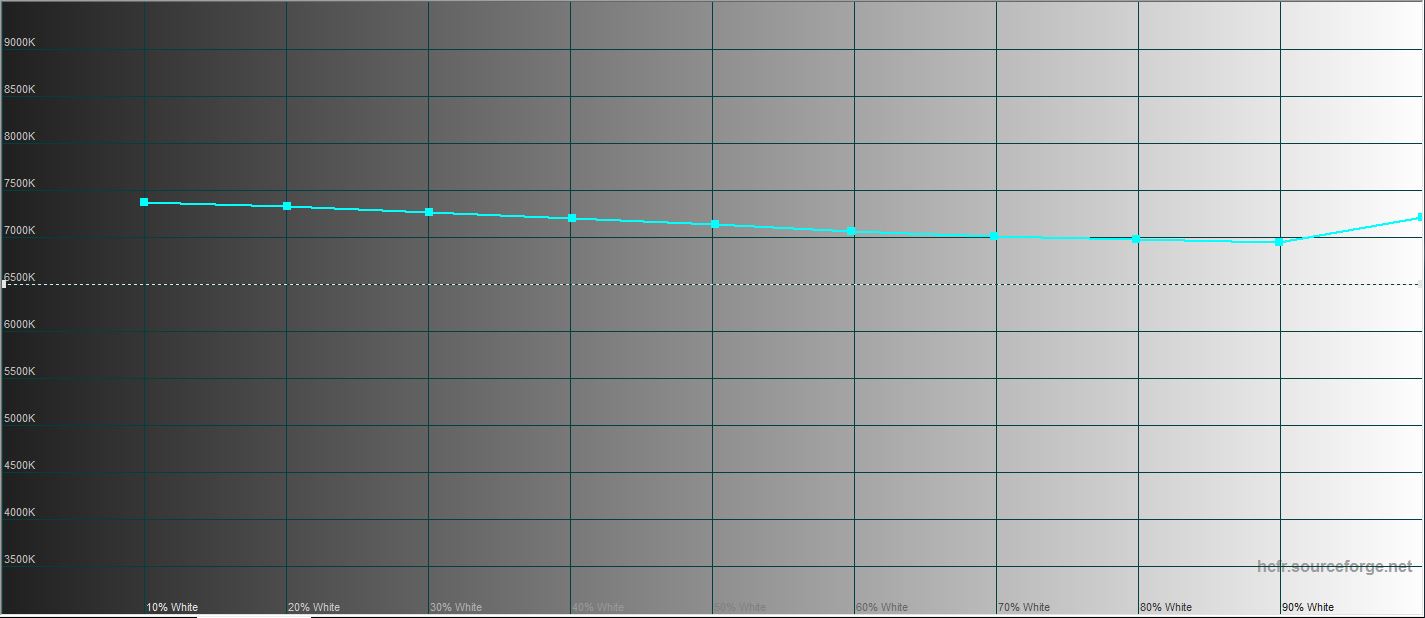
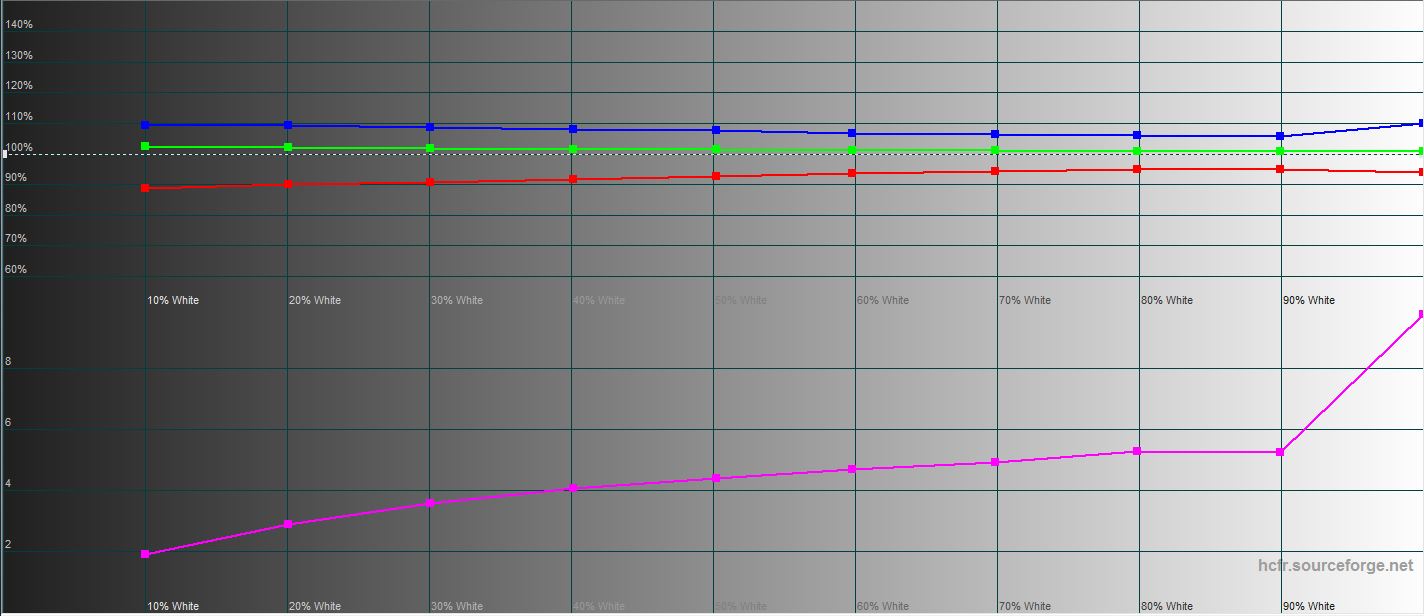
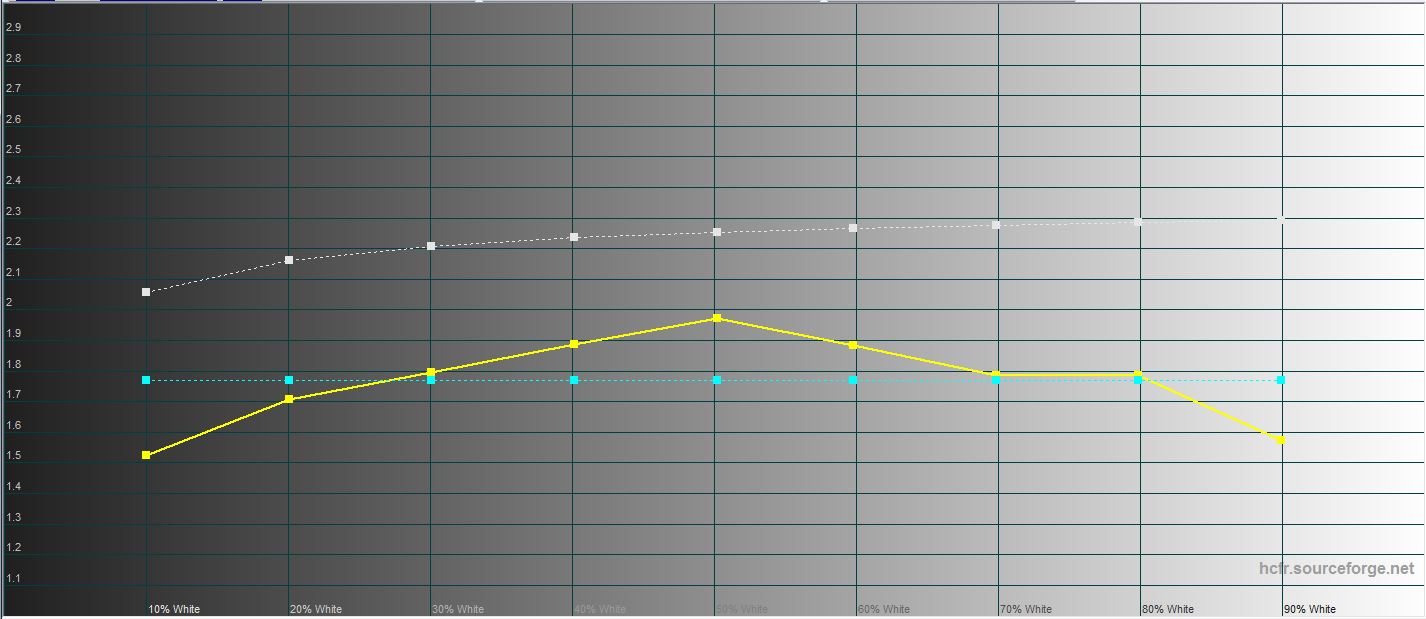






In Scenery mode the figures are very similar: the color rendering is slightly worse, but the maximum brightness is approximately the same: 722.533 cd/m².
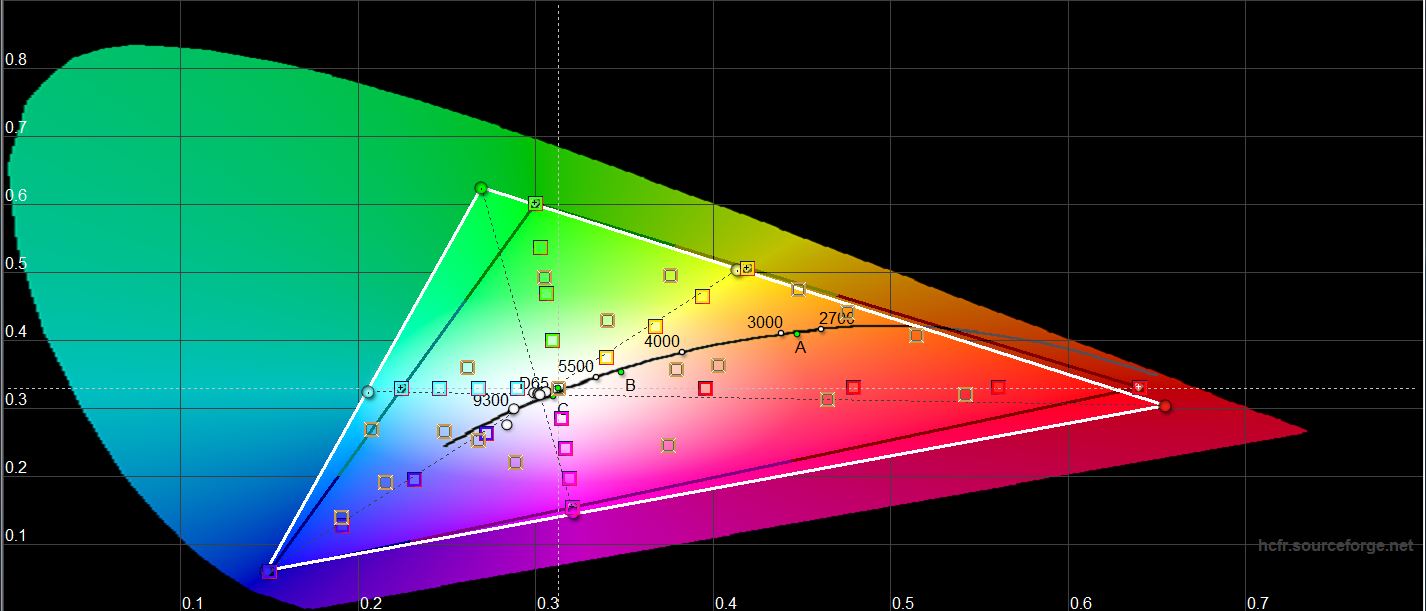


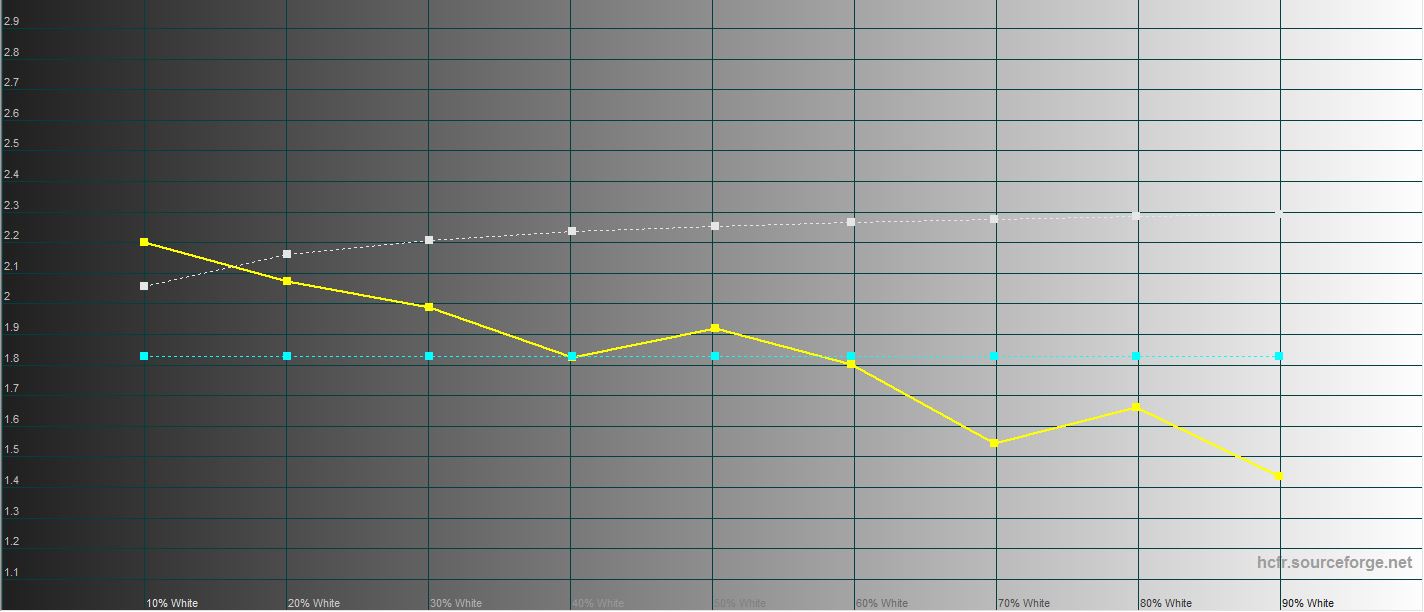






In sRGB mode, the color gamut, respectively, is very close to the sRGB color space. What's interesting is that more affordable ASUS models have had their brightness recorded in this mode. In ASUS ROG Strix XG43UQ it can be adjusted, it is slightly lower than in previous modes: 657.967 cd/m². The black field brightness is 0.36 cd/m² and contrast ratio is 1828:1.
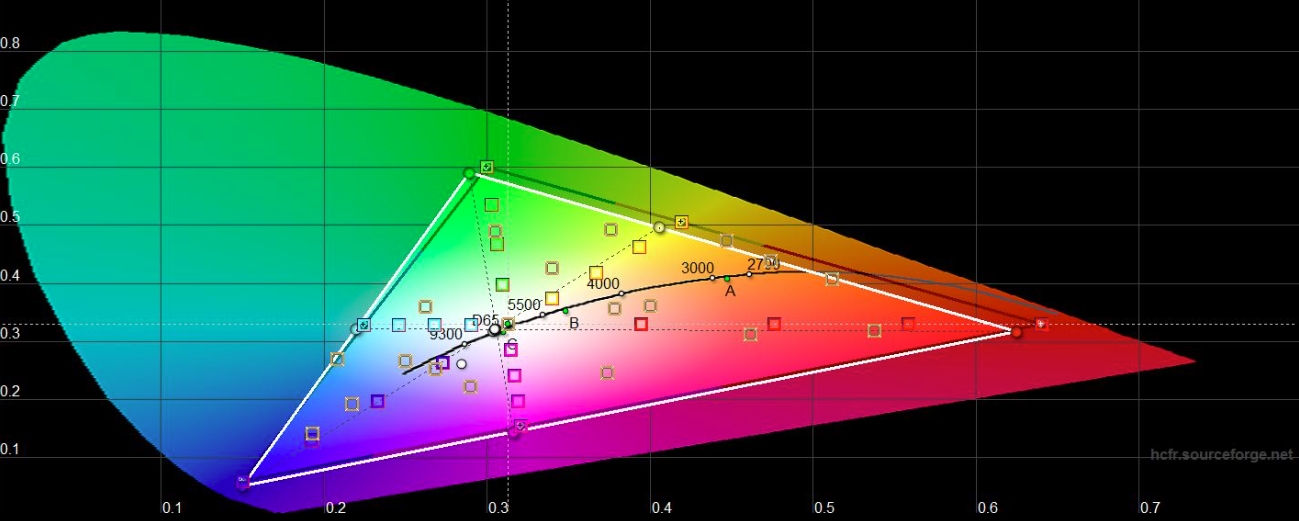

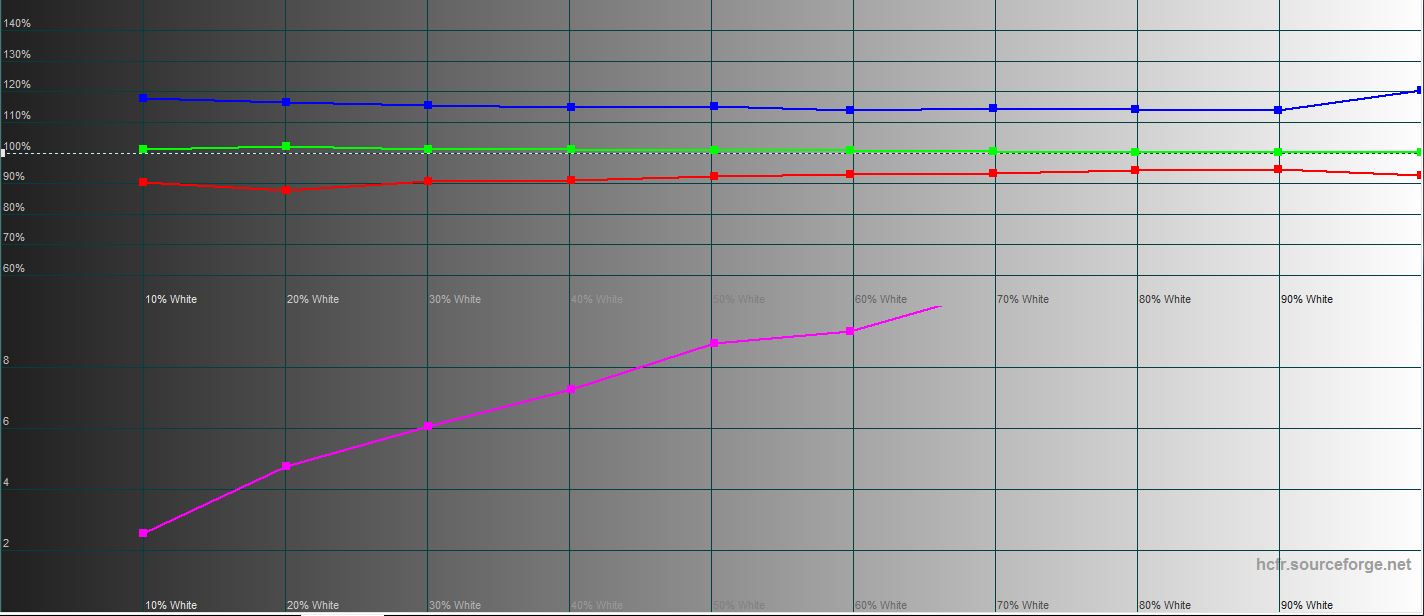







How did it perform and what about sound quality?
A bit of theory to start with. The monitor supports 4K signal with 120Hz, VRR and low latency when connected via HDMI 2.1. This is ideal for the current PlayStation 5 and Xbox Series consoles. Unfortunately, there aren't many games like this yet. On PS5 it's Destiny 2, Devil May Cry 5 SE, DIRT 5, Borderlands 3, Call of Duty: Black Ops Cold War, Tony Hawk's Pro Skater 1+2, Rainbow Six Siege and Nioh 1 and 2 Remastered. The company hasn't forgotten about PC gamers either: via DisplayPort 1.4 you can get 4K with frame rate up to 144Hz and there is support for the most advanced AMD FreeSync Premium Pro frame rate sync variant, which provides minimal delay when outputting both SDR and HDR content. Another big plus when using DisplayPort 1.4 is support for DSC (Display Stream Compression) technology. Low Pixel Response Time of 1ms (MPRT) using Extreme Low Motion Blur (ELMB) technology and matrix overclocking are other important advantages of the monitor (especially compared to TVs).
Turning from theory to practice, playing on the monitor is very comfortable, of course, if you have a modern console or a powerful gaming PC, which "pulls" the game in 4K with a decent frame rate. In these conditions the picture is very clear, smooth, without any blur, artifacts or torn frames. The only controversial point is the diagonal of the monitor. For "monitor" scenario this is a lot and you cannot sit behind the usual monitor, you need to move a little further. As a variant to install in the living room - it may seem a bit too small, especially if the room is big, and you want to sit down with friends and play some Mortal Kombat.
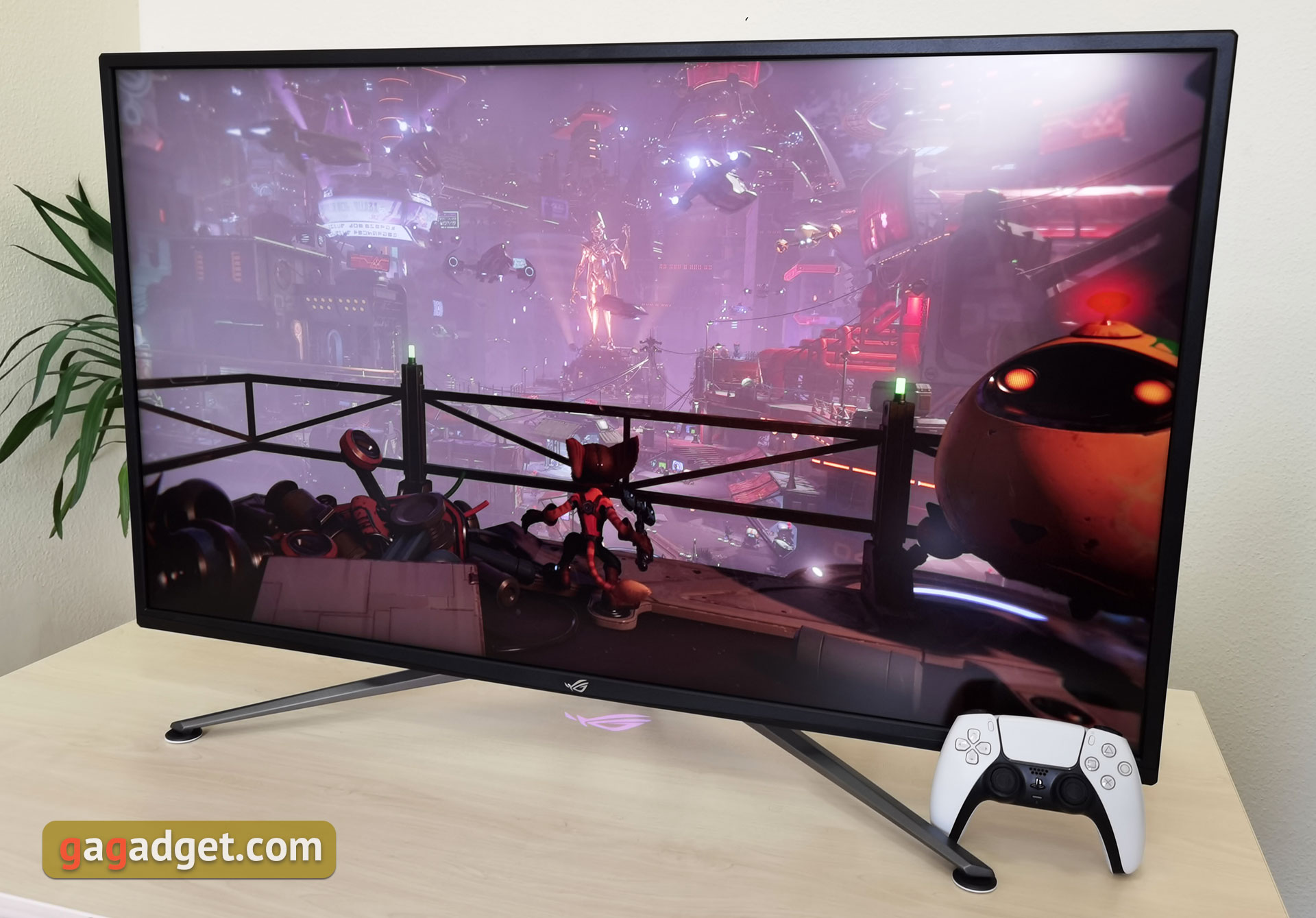
Usually, there is not much to say about the sound in monitors. The speakers are either missing or "for a tick" 2x2W. In this case a stereo system with loudspeakers 10 W each is installed which produces a very decent sound both in volume and quality. At the level of televisions of comparable size. Yes, for music lovers it will not be enough to enjoy music. But for games and movies more than enough.
Bottom line. Three things to know about the ASUS ROG Strix XG43UQ:
- The ASUS ROG Strix XG43UQ is one of the best monitors currently available for gaming, both on PC and the latest generation of gaming consoles.
- features all modern ports: 2xHDMI 2.1, 2xHDMI 2.0, DisplayPort 1.4, 2 3.5mm headset audio jacks and a USB hub.
- The monitor supports 4K, 120Hz with VRR and low latency when connected via HDMI 2.1 as well as 4K, 144Hz with AMD FreeSync Premium Pro via DisplayPort 1.4.
| ASUS ROG Strix XG43UQ Specifications | |
|---|---|
| Diagonal | 43" |
| Matrix Type | VA |
| Aspect Ratio | 16:9 |
| Resolution | 3840x2160 |
| Contrast | 4 000:1 (static), 1 000 000:1 (dynamic) |
| Viewing Angles | 178 / 178 |
| Display Color | 10 bit (8 bit + FRC) |
| Pixel pitch | 0.2451x0.2451 mm |
| Response Time | 1 ms MPRT (Motion Picture Response Time) |
| Brightness | 750 cd/m2 (1000 cd/m2 peak), HDR1000 support |
| Maximum refresh rate | 144 Hz |
| Coverage | anti-reflective |
| Connectors and ports | DisplayPort 1.4, 2xHDMI 2.0, 2xHDMI 2.1, 3.5mm audio, 2xUSB 3.0 (and signal USB 3.0), Kensington Lock |
| Wall mount | VESA 100x100 |
| Built-in speakers | 2x10W |
| Size (with stand) | 974.58x631.31x301.5 mm |
| Weight (with stand) | 15.3 kg |
For those who want to know more:
- Philips Brilliance 499P9H review: 49-inch avionic monitor
- AOC CQ32G1 review: 32-inch curved 144Hz gaming monitor
- Acer Predator X27 review: A gamer's dream monitor
- ASUS ROG Swift PG258Q review: a 240Hz gaming monitor for hardcore gamers
- ASUS ROG Strix XG32VQ review: a 32-inch curved 144Hz gaming monitor
